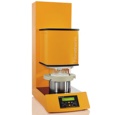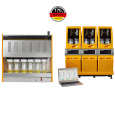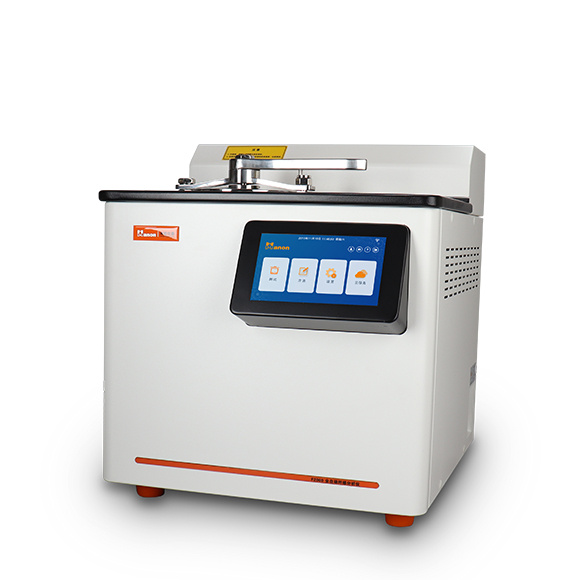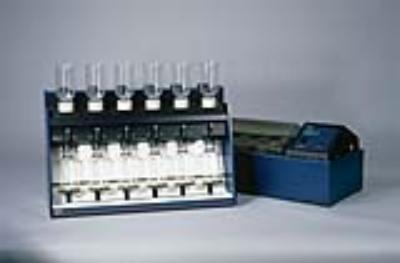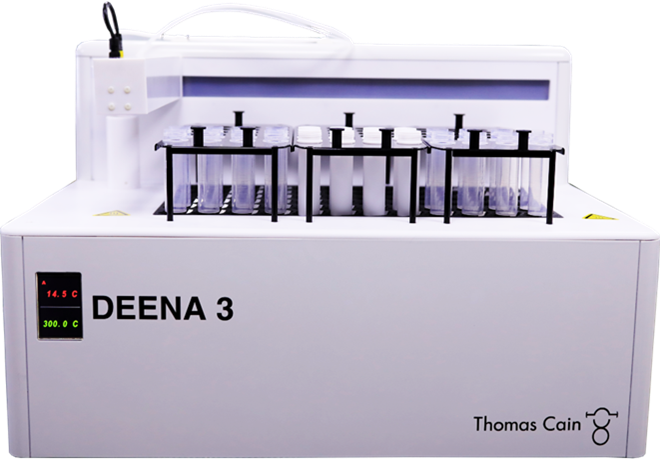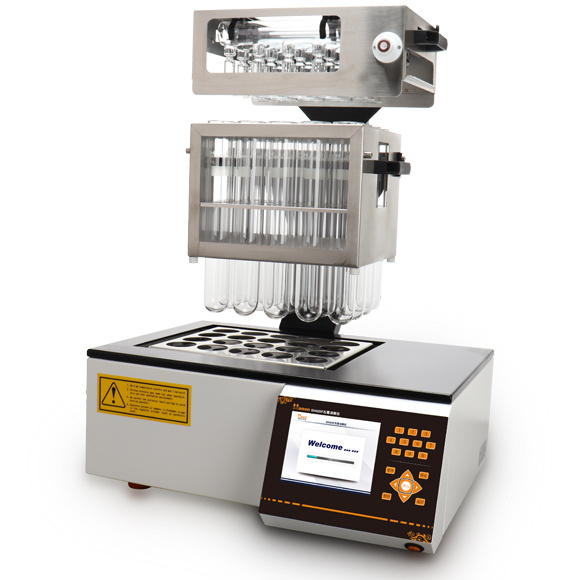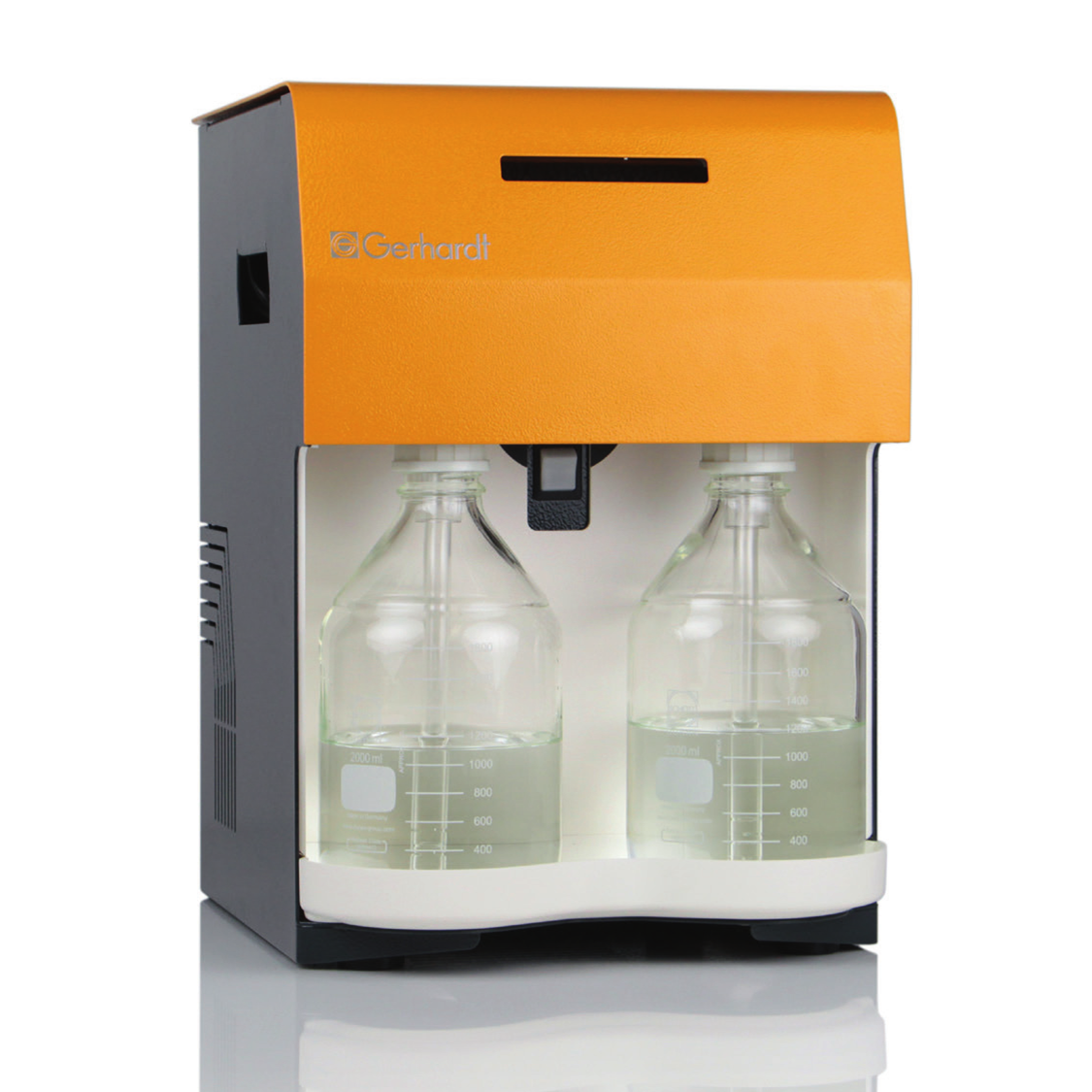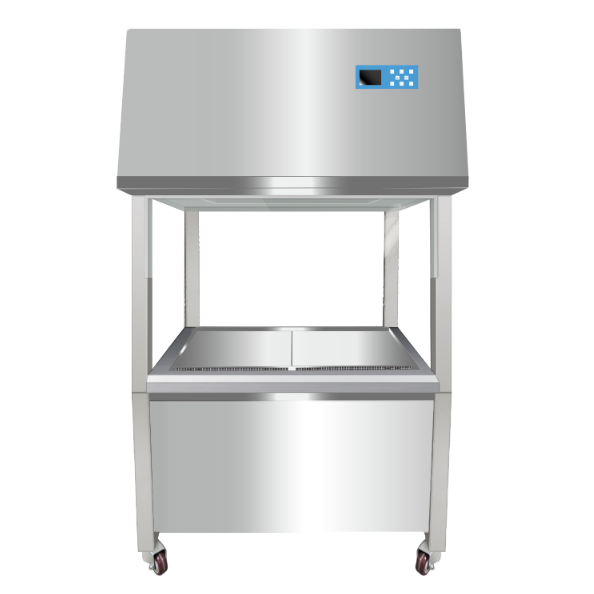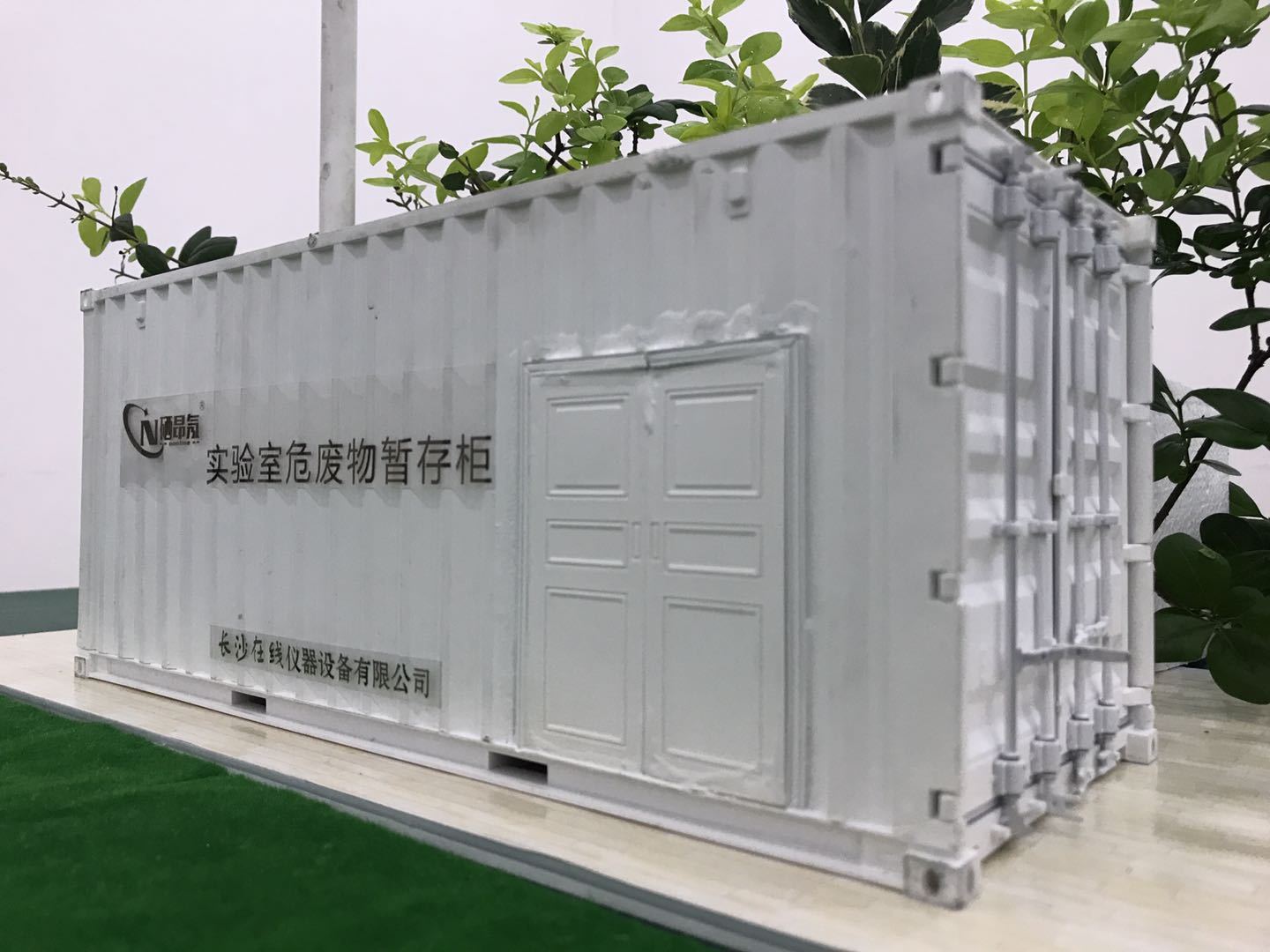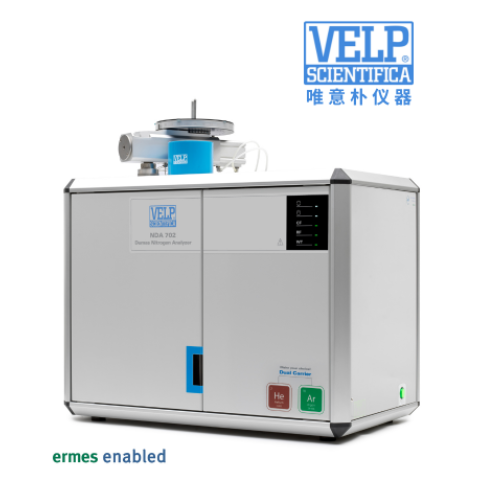方案详情
文
参照饲料检测标准,使用格哈特公司蛋白质测定仪、脂肪测定仪以及纤维测定仪检测生物质燃料马粪的粗纤维、粗蛋白、粗脂肪、中性洗涤纤维、酸性洗涤纤维、酸洗木质素含量。
方案详情

参照饲料检测标准,使用格哈特公司蛋白质测定仪、脂肪测定仪以及纤维测定仪检测生物质燃料马粪的粗纤维、粗蛋白、粗脂肪、中性洗涤纤维、酸性洗涤纤维、酸洗木质素含量。Waste and Biomass Valorizationhttps://doi.org/10.1007/s12649-023-02083-XCheck forupdatesORIGINAL PAPER Waste and Biomass Valorization Effects of Pretreatment with a Ball Mill on Methane Yield of HorseManure 球磨预处理对马粪甲烷产率的影响 Rene Heller D. Peter Roth2. Benedikt Hulsemann1·Stefan Bottinger2. Andreas Lemmer·Hans Oechsner Received: 19 August 2022 / Accepted: 10 February 2023 ◎ The Author(s) 2023 Abstract Lignocellulosic biomass is an abundant organic material, which can be utilised in biogas plants for sustainable productionof biogas. Since these substrates usually have high lignin contents and consist of rather elongated particles, a specialpretreatment is required for an economical and process-stable utilisation in the biogas plant. The mechanical pretreatmentof horse manure was carried out with the prototype of a ball mill at different speeds. The aim of ball milling is to comminutethe substrate and disintegrate the lignocellulosic bond. Mechanical pretreatment in the ball mill resulted in a significantincrease in specific methane yield of more than 37% in anaerobic batch digestion (up to 243 Lcnakgys) of horse manure.The kinetics of the methane gas formation process was analysed by a modified Gompertz model fitting and showed a highermethane production potential and maximum daily methane production rate as well as a lower duration of the lag phaseafter pretreatment at 6 rpm. This was further confirmed by sieve analyses, which showed a significant reduction of particlesize compared to the untreated variant. Thus, the use of the ball mill increases the specific methane yield and improves thefermentation of lignocellulosic substrates such as horse manure. 区Rene Heller Rene.Heller@Uni-Hohenheim.de Peter Roth Peter.Roth@Uni-Hohenheim.de Benedikt Huilsemann Benedikt.Huelsemann@Uni-Hohenheim.de Stefan Bottinger Boettinger@Uni-Hohenheim.de Andreas Lemmer Andreas.Lemmer@Uni-Hohenheim.de Hans Oechsner Hans.Oechsner@Uni-Hohenheim.de State Institute of Agricultural Engineering and Bioenergy,University of Hohenheim, Stuttgart, Germany 2 Institute of Agricultural Engineering, Universityof Hohenheim, Stuttgart, Germany Time (d) Keywords Mechanical disintegration· Anaerobic digestion· Lignocellulose· Specific methane yield·Particle size Statement of Novelty The specific objective of this research was to investigatethe influence of mechanical pretreatment of a newprototype ball mill on the specific methane yield andparticle size distribution of horse manure. For this purpose, different rotational speeds of the ball mill wereinvestigated, at constant filling weight. Since horsemanure consists mainly of lignocellulose, which canlead to problems such as floating layers and incompletedigestion, pretreatment is necessary before the substrateis added to the fermenter of a biogas plant. The results are new and therefore of importance for the pretreatmentof lignocellulosic residues such as horse manure foranaerobic digestion at plant scale. Introduction Lignocellulosic biomass is an abundant organic material,which can be utilised in biogas plants for sustainableproduction of biogas [1]. The utilisation of agriculturalby-products, wastes, and lignocellulosic residues, such ashorse manure, offers the possibility of reducing feedstockcosts and also reducing land-use competition between foodproduction and biogas production [2]. In addition, Angelidakiand Ahring [3] state that the use of farm wastes allows tothe conversion of manure, which is normally considered tohave little or no commercial value, into renewable energy.The structural characteristics of lignocellulosic substratesare a common problem affecting the efficient valorizationof many agricultural wastes [4, 5]. Lignocellulose is mainlycomposed of cellulose, hemicellulose and lignin, whichare cross-linked together and make the plant structuresflexible and resistant [6-8]. This cross-linking stabilises theplant cell wall and protects it from enzymatic or microbialdegradation [4, 7-9], preventing lignocellulosic biomassto reach efficient hydrolysis [6, 10]. Anaerobic digestion(AD) can convert both cellulose and hemicelluloseof the lignocellulosic substrate, while lignin remainsundigested [11]. In order to increase the biodegradability oflignocelluloses and to utilise agricultural waste, pretreatmentis an essential element for the economic operation of biogasplants [10, 12]. Pretreatment methods can be generallycategorised into physical, chemical and biological or acombination of these methods [1, 4, 12-14]. Chemicalpretreatment methods cover alkaline, acid, catalyzed steamexplosion, wet oxidation, oxidative pretreatment withperoxides and ionic liquids, while biological pretreatmentmethods can be carried out by fungi, enzymes or a microbialconsortium. Physical pretreatment techniques includemechanical comminution, steam-explosion, liquid hot waterpretreatment, extrusion, and irradiation like ultrasoundand microwave [1, 15]. Various mechanical pretreatmentprocesses such as grinding, shredding, crushing, or choppingare already available for the large-scale biogas process [16].Mechanical pretreatment usually causes a particle sizereduction, alteration of cell walls to increase the enzymeaccessibility [17] and an increase in the surface area of theorganic material, which provides a larger contact area formicroorganisms to degrade the material, resulting in a higherbiogas yield [18-21]. In addition, the reduction of particlesize can accelerate the kinetics of the degradation and gasformation processes of lignocellulosic substrates [18, 22],reduce the risk of process-related engineering problems such as floating layers in the digester [23,24] and recalcitrance ofsolids to enzymatic breakdown [25]. Fernandez et al. [17]mention energy savings of pumping and mixing operationsin the digester as another objective of substrate pretreatment.Monch-Tegeder et al. [26] investigated grinding of horsemanure with a cross-flow grinder (Bio-QZ, ANDRITZMeWa GmbH, Gechingen, Germany). A collision reactor.C11with a rapidly rotating chain was filled with a portion ofsubstrate which was grinded for 15 s. The batch digestiontest was conducted according to the guidelines of theVDI 4630 [27] in glass bottles with a working volume of2,000 mL for 35 days. The pretreatment led to an increasein methane yield of 9.2% compared to the control variant.Another investigation of Monch-Tegeder et al. [24] showedan increase of 26.5% in methane production of a pretreatedsubstrate mixture (liquid manure, horse manure, solidmanure, grain silage, maize silage, grass silage, crushedgrain) compared to the untreated material. This full-scaleexperiment was carried out in two continuous stirred tankreactors with working volumes of 800 m’each. During anexperimental time of 160 days one digester was fed withthe pretreated and the other one with the untreated substratemixture. The specific energy consumption of the cross-flow grinder accounted to 11.3±1.3 kWh teM for thepretreatment of the substrates during this trial. By the application of a pretreatment machine (coarse steelroller against a steel roller at a rotating speed of 400 rpm)on meadow grass, Tsapekos et al. [28] showed an enhancedmethane yield of up to 27% compared to untreated samples.Batch digestion was conducted in glass bottles of 547 mLtotal volume at a thermophilic temperature of 54°℃. Gallegos et al. [29] evaluated the effect of particle sizereduction on wheat straw. The substrate was pretreated bymeans of chopping to a particle size of 2.0 cm by a straw-milland grinding to a particle size of 0.2 cm by a bio-extruder. Thetest was operated under mesophilic conditions of 38°C. Thebatch digestion was conducted using eudiometer devices inaccordance with VDI 4630. The mechanical pretreatment ofwheat straw increased the methane yields by up to 26%. In the present study, a prototype ball mill wasinvestigated, which represents a new type of mechanicaldisintegration process for fibre-rich and lignocellulosicfeedstocks in the biogas sector [30]. The objective was toanalyse the effects of mechanical pretreatment on specificmethane yield and particle size distribution of horse manure.The used prototype of the ball mill is novel and unique inthe biogas sector. Materials and Methods Ball Mill The ball mill used in this study is patented as a comminutiondevice, especially for the mechanical pretreatment of fibre-rich biomass for biogas production, under German patentnumber DE102019106792A1 [31]. The prototype of thisball mill was developed and built by Biokraft Energietechnik(Biokraft Energietechnik GmbH, Stuttgart, Germany) andis located at the biogas plant Heuberghof (Bio-EnergieHeuberg GmbH & Co. KG, Balingen, Germany). It consistsof a cylindrical rotating drum unit of 2 m diameter and 3 mlength mounted on a truck tandem axis (Fliegl FahrzeugbauGmbH, Triptis, Germany). The ball mill is driven by a45-kW electric motor (MOLL-MOTOR, MechatronischeAntriebstechnik GmbH, Stockerau, Austria) and is filledwith about 2500 kg of grinding balls with a diameter of80 mm. Figure 1 shows different views of the prototype ball milland its components. The grinding balls are made of cast ironand have an average weight of 2.1 kg. Iron rods are welded to the inner wall of the drum to carry the grinding balls upand drop them onto the substrate. The resulting collisions and interactions of the grindingballs with the substrate lead to frictional and impact forceswhich grind and comminute the substrate, reduce the particlesize and thus increase the particle surface area. Mechanical comminution occurs in continuous operationand can be influenced by various parameters such asrotational speed, drum filling weight, grinding media,substrate composition and substrate feed rate. As the ball mill is equipped with load cells (combinederror ≤±0.03%), the actual weight of the substrate in thedrum is permanently measured. The automated feed enablesthe feeding of fresh substrate as soon as the filling weightof the drum falls below the set value. The level control alsoallows the desired amount of substrate to be treated duringa trial. The substrate is treated in a continuous flow inside thedrum and gets transported to the discharge disc and pushedthrough it. Pretreated substrate is then fed to the biogas plantvia screw conveyors. Substrate Properties Substrates Investigated The ball mill was fed with a mixture of horse manure andwheat straw during this study. The horse manure used inthis study was collected from a horse farm near Balingen(Hofgut Reichenbach—EQH Egenter Quarter Horses,Balingen, Germany). The matured horse manure was8-12 weeks old and therefore very moist and adhesive. Toreduce moisture of the horse manure and the adhesion inthe ball mill, wheat straw was added in the form of squarebales (300±30 kg) in the dosing unit prior to the ball mill.The ratio of horse manure to wheat straw was adjusted to4:1 in all trials. Before the substrate was automaticallyadded to the ball mill for the disintegration process, itwas fully mixed in a solids dosing unit for 30 min beforeeach trial run. Most equine waste that can be considered for anaerobicdigestion consists of manure and some type of stablebedding [33-36]. In this paper, the term horse manureis used to refer to horse excrement and urine mixed withstraw bedding material and then removed from stalls. Mechanical Pretreatment and Sampling In this experiment, the rotation speed of the ball mill wasvaried to investigate the effect on particle size and specificmethane yield. Three experiments were conducted atthree different rotational speeds of 6, 10 and 14 rpm. Thedrum was cleaned before the trials and emptied after eachtrial. The substrates horse manure and wheat straw weresuccessively added to the solids dosing unit using a wheelloader. With the start of each trial, the mixed substratespassed through the ball mill at the set speed. The fillingweight of 1.5 t substrate in the drum was kept constantduring the experiments. Samples of treated substratewere taken from below the discharge disc after 0.5 t ofthe substrate had been milled in continuous operation.For sampling, a special sample vessel was placed belowthe discharge disc along its entire length to obtain homogeneous samples of treated horse manure. For eachtreatment variation, a reference sample of the untreatedsubstrate was taken. In order to obtain homogeneous untreated samplesof the substrate, the samples were taken after completeagitation at the outlet of the solid dosing unit. After thesampling, both the untreated and treated samples wereimmediately shock frozen with liquid nitrogen and thenstored at - 20 °℃ to prevent further degradation of organicacids. The experimental data was recorded in a databaseconnected to the ball mill to facilitate subsequent dataanalysis and calculations. Batch Digestion Test The determination of methane potential of differentlypretreated horse manure in the ball mill was performedusing the Hohenheim Biogas Yield Test (HBT). TheHBT is a patented method with high reproducibility [37]and was performed according to the VDI Guideline 4630[27] as described by Helffrich and Oechsner [38] andMittweg et al. [39]. The method largely agrees with themethod described by Hollinger et al. [40]. Since the HBTtest provides information about the actual fermentationprocess and degradation kinetics, the sample preparationhas to correspond as closely as possible to the subsequentpractical conditions according to VDI Guideline 4630[26]. Therefore, the substrates were assayed using the HBTwithout any additional laboratory pretreatment, as furthercomminution would have significantly biased the samplesfrom the practical trials. High standard deviations wereexpected due to the small fermenter size, in particular forthe untreated variant. Horse manure was digested in 100 mL glass syringesfilled with 30 g of inoculum and 0.8 g of sample material,corresponding to an inoculum-to-substrate ratio of 3.42:1,based on volatile solids. The glass syringes served simulta-neously as digestion chambers and gas containers, as shownin Fig. 2. Each treatment variant was run as a replicate of ninesamples, while the untreated variant was run as a replicateof 27 samples, as horse manure is known as a heterogeneous Fig.2 Glass syringe to deter-mine specific methane potentialin HBT anaerobic batch diges-tion [41] substrate. Over a period of 35 days, batch digestion wasperformed under mesophilic conditions at a constanttemperature of 37±0.5℃. The methane content of the dried biogas produced wasmeasured manually using an infrared spectrometric methanegas sensor (Advanced Gasmitter, Pronova Analysetechnik,Berlin, Germany) and was related to the gas volume. Thesensor was calibrated before and after each measurementwith a calibration gas mixture of 60% CH and 40% CO2(G325792 Compressed gas, Westfalen AG, Miinster,Germany) [42]. Before measuring the gas volume, thegas was dried with an absorbent (SICAPENT@, Merck,Darmstadt, Germany). The measured gas volumes werecorrected to standard temperature and pressure of 273.15Kand 1013.25 hPa. The procedure of gas measurements isdescribed in detail by Mittweg et al. [39] and Hilsemannet al. [42]. For the determination of the specific methane yieldof horse manure, the inoculum was tested separately inHBT syringes without co-digestion substrate. In addition,a hay and concentrate standard with known gas yieldswere digested to verify the accuracy of the experimentalconditions according to VDI 4630. The results of thecumulative specific methane yields were related to thevolatile solids content of the samples (LcH4 kgvs). Inoculum The inoculum for the HBT was obtained from thesecondary digester of a biogas plant in Laupheim, Germany(Biokraftwerk Deubler GbR, Laupheim, Germany), whichis operated at a mesophilic temperature of 42 °C. Freshsamples of inoculum were analysed for pH and FOS/TAC(785 DMP Titrino, Metrohm, Herisau, Switzerland) in thelaboratory of the State Institute of Agricultural Engineeringand Bioenergy (University of Hohenheim, Stuttgart,Germany) according to VDLUFA guidelines [43].Theinoculum used had a pH of 7.92 and a FOS/TAC value of0.169, which were in a suitable range for further use in theHBT batch digestion test [44]. Prior to the HBT, the inoculum was screened using asieve with a mesh size of 0.7 mm to remove bigger particles.The determination of the total solids (TS) content resulted ina value of 5.46% fresh mass (FM) and a volatile solids (VS)content of 70.80% TS (3.87% FM). Dry Sieve Analyses Sieve analysis is one of the oldest methods of particlesize analysis. A known sample weight is passed throughprogressively finer sieves. The amount collected on eachintermediate sieve is weighed to determine the percentweight of each size fraction [45]. Sieve analysis was performed according to DIN ISO 66165-2:2016-08[46]as dry sieving and on a Fritsch Analysette 3 Spartan two-dimensional vibratory sieve shaker (FRITSCH GmbH, Idar-Oberstein, Germany). Due to the vibration, the individualparticles were collected in the intermediate sieves withmesh sizes of 8,4,2,1,0.5,0.25 mm and the sieve panat the bottom, which were arranged in descending order.The samples were dried at 105 ℃ for 24 h before sieving.For each sieve pass, 15 g of dried horse manure wasweighed before sieving. The samples were then placed onthe sieve with the largest mesh size and sieved for 10 minat a set amplitude of 2 mm. Before and after sieving, eachintermediate sieve was weighted on a laboratory balance(KERN EG 4200-2NM, Kern&Sohn GmbH, Balingen,Germany). This procedure was performed in triplicatefor each treatment variant (6, 10 and 14 rpm) and for theuntreated reference. The particle size distributions wererelated to the total solids (% TS) of the substrate's testes. Microscopy The surface morphology of horse manure was observedusing a Greenough Stereo Microscope (Zeiss Axio Zoom.V16, Carl Zeiss Microscopy GmbH, Jena, Germany),to analyse the surface destruction of the treated samplecompared to the untreated reference. Pretreated substrateat 6 rpm and the untreated reference were analysed underthe microscope. The microscope is equipped with a12-megapixel microscope camera (Zeiss Axiocam 712 color,Carl Zeiss Microscopy GmbH, Jena, Germany) and wasused at different magnification levels of 7x up to 40x. Withthe possibility of Z-stacking integrated into the analysissoftware ZEN core (ZEN core Version 3.3.92.00000, CarlZeiss Microscopy GmbH, Jena, Germany), the depth of fieldcould be extended at high magnification levels. Chemical Composition Analysis TS and VS Total solids (TS) and volatile solids (VS) content of eachsample were determined prior to the experimental run ofbatch digestion and sieve analysis. By drying the samples at105 ℃ (UF450, Memmert GmbH, Schwabach, Germany)to constant weight, the total solids content was determinedaccording to DIN EN 12880:2000 [47] and Frydendal-Nielsen et al. [48]. Subsequently, the samples wereincinerated at 550°C in a muffle furnace for 6 h accordingto DIN EN 12879:2000 [49] to determine the volatile solidscontent. The concentrations (g kgrs) of crude protein (XP), crudefat (XL), crude fibre (XF) and nitrogen-free extract (NfE)of the samples were analysed by the analytical laboratoryof Gerhardt Analytical Systems (Gerhardt GmbH & Co.KG, Konigswinter, Germany) according to the Europeanregulations for the Weender feed analysis [50, 51]. The concentrations of neutral detergent fibre (NDF),acid detergent fibre (ADF) and acid detergent lignin (ADL)were also analysed in the analytical laboratory of GerhardtAnalytical Systems (FibreBag Analysis System, GerhardtGmbH & Co. KG, Konigswinter, Germany) using thestandard methods described by the Association of GermanAgricultural Analytic and Research Institutes (VDLUFA)[43]. Calculations and Statistical Analyses Modified Gompertz Model The modified Gompertz kinetic model has been commonlyused to describe biogas production mathematically [52-59]assuming that the biogas production rate under batchconditions is a function of the bacterial growth rate of thepredominant bacteria in the digester: where M represents cumulative methane production(LcH4 kgvs-) after digestion time t (d), P representsmethane production potential (LcH4 kgvs), Rm representsmaximum daily methane production rate (LcH4 kgvs-d-),A represents lag phase duration (d), and e equals exp(1),or 2.7182818. The kinetic constants of P, R and a weredetermined using non-linear regression analysis (MicrosoftExcel Solver Add-In, Microsoft Corporation, Redmond,USA). For each sample of the batch digestion test in theHBT the modified Gompertz fitting has been performed andsubsequently the mean value and standard deviation werecalculated. Energy Balance The energy consumption and treatment time was recordedfor each trial and calculated as the specific energyconsumption (SEC) per ton一 (t) fresh mass in kWh tpM1Additional specific methane yield (SMYAdd) was calculatedfrom the difference between the yield of the pretreatedsample in the ball mill and the yield of the untreated sample (in m’cH4 trM). Energy surplus (ES) due to treatmentwas calculated by following equation: where, LHV is defined as lower heating value of 1 m’CH4which is 9.97 kWh [44] and ncHp is the electrical energyconversion efficiency of the combined heat and power unit,which was assumed to be 38% for the conversion frommethane into electrical power [26]. The energy balance (EB) was calculated by followingequation: which describes the additional energy yield obtained aftersubtracting the specific energy consumption needed for thepretreatment process (SEC) from the energy surplus (ES)generated by the pretreatment of horse manure. The energy recovery rate (ER) was determined based onthe ratio of methane energy (ME) recovered from digestionto the gross energy content (GE) of the substrate. The gross energy content (GE) of the substrates,expressed in MJ kgvs, can be estimated from the results ofthe Weender feed analysis and using the following equation[60]: The specific energy content of the component parametersexhibits certain differences, as can be seen from the fixedcoefficients of the equation [41]. Statistical Evaluation Since the data had a normal distribution and homogeneousvariance, statistical significance (p<0.05) was tested by one-way ANOVA (Excel, Microsoft) followed by Tukey-Kramerpost-hoc test using the Real Statistics Resource Packsoftware XRealStats for Excel [61] for statistical analysesof particle size and specific methane yields. Outliers were determined and excluded from the datausing OriginPro 2020 statistical analysis and visualisationsoftware. The criterion for determining outli1g0ers was theinterquartile range (IQR) multiplied by 1.5. The graphs were created using OriginPro 2020. Table 1 Chemical composition of untreated and pretreated horse manure Determination method Unit Variant of treatment for horse manure Untreated BM6rpm BM 10 rpm BM 14 rpm Total solids (TS) %FM 49.74 53.42 50.45 48.07 Volatile solids (VS) %TS 84.85 85.67 82.51 83.87 Crude protein (XP) gkgTs -1 68.37 72.65 77.39 69.83 Crude fat (XL) gkgTS 一1 14.84 15.04 13.98 15.15 Crude fibre (XF) gkgTS 一1 423.03 398.09 406.92 403.30 Neutral detergent fibre (NDF) gkgTS 一1 715.54 675.79 671.33 673.53 Acid detergent fibre (ADF) gkgTs 一1 521.99 527.61 525.74 519.01 Acid detergent lignin (ADL) g kgTS -1 122.01 139.79 139.49 134.66 Nitrogen free extracts (NfE) g kgTs -1 403.40 425.51 404.34 414.12 Gross energy (GE) MJ kgvs 二1 15.13 15.20 14.67 14.73 BM treated horse manure in ball mill; FM fresh mass; TS total solids; VS volatile solids Results and Discussion Chemical Composition of Raw Materials The compositions of the raw materials are listed in Table 1.Due to the weighing inaccuracy of the solid dosing unit,there were slight variations in the substrate compositionof horse manure and wheat straw. The average total solidscontent of the substrates was 50.42% FM and varied from48.07 to 53.42% FM. Contents of volatile solids showeda mean value of 84.23% TS and varied from 82.52 to85.67% FM. Nevertheless, all samples had similar TS andVS content after agitation. The average ADL fraction of the horse manure was139.99 gkgrs, with the untreated variant having the lowestacid detergent lignin (ADL) content of 122.01 g kgrs.For NDF, the untreated variant showed the highest valuewith 715.54 g kgTss-compared to the mean value of684.05 gkgTs. The XP, XL and XF values were of the same orderof magnitude for all treatment variants. The chemicalcompositions of the different treatment variants arecomparable to the results of the stored horse manure samplesstudied by Monch-Tegeder et al. [58]. The calculatedgross energy content (GE) of horse manure ranged from14.93±0.27 MJkgvs一1 Pretreatment Process Data In the studies it was shown that in continuous operation andwith a constant filling weight of the ball mill, the flow rateincreased as the speed of the mill increased. The retentiontime of horse manure in the ball mill decreased sharplywith increasing speed. At a speed of 6 rpm, the millingtime increased almost fivefold compared to 14 rpm. Thehighest flow rate was found at 14 rpm with 0.924 tem h,followed by 0.494 trM h- at 10 rpm and 0.201 teM h-at Fig.3 Specific energy consumption and additional methane yield inrelation to the flow rate at a constant filling weight of the ball mill of1.5 t, measured during each treatment of 0.5 t of horse manure 6 rpm. Clogging was observed at the discharge disc withtime. Longer milling led to more intensive clogging atthe discharge disc in the tests. The decisive factor for thiswas the matured horse manure, which was between 8 and12 weeks old and thus adhered very strongly to the innerwall of the drum and the discharge disc. This limitation isnot expected with fresh material. Fresh horse manure, whichis utilised without intermediate storage, remains relativelydry due to its high straw content and can thus be processedmuch more efficiently in the ball mill. Adhesions on theinner wall, which lead to decreasing flow rates, can thus belargely avoided. The logged experimental data including specific energyconsumption and additional methane yield as a function offlow rate are shown in Fig. 3. It could be shown that as the speed increases, the numberof revolutions and the energy consumption for the same treatment time increase. In this experiment the specificenergy consumption of the ball mill varied between 24.5and 41.5 kWh teM. In its trials with fresh horse manure, themanufacturer of the prototype ball mill reported an averagespecific energy consumption of 6.5 kWh teMat a flow rateof 4.5 tem h- which is significantly lower than the valuesreported in the present work [62].71、 Zheng et al. [1] mention that the size reduction is a veryexpensive operation, which can consume up to 33% of thetotal electricity demand for the whole process dependingon the comminution method. They conclude that reducingthe energy demand and increasing efficiency for grindingor milling of biomass at the same time would improve theeconomic performance of the whole process. Effects of Pretreatment on the Degradation Kinetics The experimental data of cumulative specific methaneyields in the HBT were fitted to the modified Gompertzmodel for each sample of the respective treatment variant.The results of the modified Gompertz kinetic model showa strong correlation to the data points of the cumulativespecific methane yields determined in the HBT. To assessthe efficiency of the model, the adjusted coefficient ofdetermination (Adj. R) was used. Overall, the values werehigh at over 0.9786 for all treatment variants (see Table 2)with accordingly low error values. This shows that the modelis reliable and accurate in predicting the methane yield [63]. Methane production potential (P) was higher for alltreatment variants compared to the untreated reference.A significant difference (significance level p<0.05) inmethane production potential was observed between theuntreated variant and 6 rpm, and between 6 and 10 rpm.The highest value was 241.6±16.0 LcH4 kgvsat 6 rpm,an increase of 37.16% compared to the untreated variantwith 176.2±44.1 LcH4 kgvs. Significant differences werefound for the maximum daily methane production rate(Rm), between the untreated variant and 6, 10 and 14rpm(significance level p<0.05). Among the pretreated variantsthe value of Rm did not show much variation. Statistical analysis by a Tukey-Kramer post-hoc test (sig-nificance level p<0.05) revealed significant differences in Fig.4 Cumulative particle size distribution; data points representmean values and shadows the standard deviations; BM=treated horsemanure in ball mill the duration of the lag phase (A) between the untreated vari-ant and 6, 6 and 10, as well as between 6 and 14 rpm. Witha duration of only 0.8 days, the treatment variant at 6 rpmachieved the lowest lag phase, which means that methaneproduction started about half a day earlier compared to theuntreated variant. At 10 and 14 rpm, the duration of the lagphase was in a similar range to that of the untreated variant(1.3 days). Kusch et al. [64] reported that chopping the horsemanure twice with a compost chopper to a length of 4 cmsignificantly accelerated biogas production. It can be concluded that the mechanical pretreatment hada significant effect on the specific methane yield as well asthe degradation kinetics of the horse manure, especially forthe sample treated at 6 rpm in the ball mill. Effects of Pretreatment on Particle Size The changes in the physical structure of the horse manuredue to the disintegration process with the prototype ball millwere demonstrated by dry sieve analysis. Determina- Unit A variant of treatment for horse manure tion method Untreated BM6rpm BM 10 rpm BM 14rpm P LCH4kgys 176.2±44.1 241.6±16.0 190.4±32.0 212.0±28.4 Rm LCH4kgys d- 14.3±3.6 17.8±1.1 17.8±1.9 17.9±1.6 入 d 1.3±0.3 0.8±0.2 1.2±0.2 1.3±0.2 Adj.R 一 0.9791±0.0060 0.9787±0,0041 0.9796±0,0117 0.9786±0,0059 BM treated horse manure in ball mill; VS volatile solids; P methane production potential; R maximumdaily methane production rate; A lag time) Figure 4 shows the results as a cumulative distributioncurve for each treatment, with each intermediate sievedescribing one data point. The curves for the variants treatedin the ball mill show a remarkable reduction in particle sizecompared to the untreated reference. The curve at 6 rpmstands out clearly from the other treatment variants due tothe intensive pretreatment and longer milling time. Graphsof the curves at 10 and 14 rpm show similar curve shapesand a significant reduction in particle size compared to theuntreated variant. The overall low standard deviations withinthe pretreated samples show a high repeatability of the sieveanalysis. Statistical significances (significance level p<0.05) ofsieve fractions between treatment variants were performedas Tukey-Kramer post hoc test. All treatment variantsshowed a significantly lower percentage of particles largerthan 8.0 mm. The strongest effect of the milling treatmenton particle size was found in the 6 rpm sample, which had amean value of 3.25% compared to 40.00% for the untreatedvariant. The sieve fraction of 2.0-4.0 mm was significantlyhigher at 6 and 14 rpm compared to the untreated variant.For particles of 1.0-2.0 and 0.5-1.0 mm, a significantlyhigher percentage was observed for all treatment variantscompared to the untreated variant. A significant differencewas also found for microparticles smaller than 0.25 mmcompared to the untreated variant at 6 rpm. Fernandez et al.[17] concludes, that particle size reduction is an essentialparameter on the methane yield, nevertheless other factorssuch as solubilisation and bioavailability of organic matteralso play an important role. Since horse manure consists mainly of irregularly shapedparticles, Wills and Finch [45] point out that sieving iscomplicated by the fact that a particle with a size close tothe nominal aperture of the test sieve can only pass if it is in a favourable orientation. Since the size of the sieveapertures inevitably varies due to the irregularity of themeshes, longer sieving results in the larger sieve aperturesexerting an excessive influence on the sieve analysis. For thisreason, the amplitude of the vibratory sieve shaker was set at2 mm to compromise between the throw height that sievinggenerally requires and the negative effect of verticalisationand drop-through of the mostly elongated particles ontosmaller intermediate screens that occurs at high amplitudes. Effects of Pretreatment on the Surface Morphology Figure 5 shows images at different magnifications under theAxio Zoom. V16 from Zeiss. The sample of the untreatedvariant consists of significantly larger particles of horsemanure and straw particles (Fig.5A and B) compared to thepretreated variant at 6 rpm (Fig. 5E), as well as substratecompounds, as shown in Fig. 5C, which cannot be separatedwithout mechanical pretreatment. Broken particles are alsopresent in the untreated sample (Fig.5D) but show onlyminor kinks and are much less frayed. In the pretreated variant, relatively smaller particles aswell as predominantly broken and chipped particle ends arefound in the sample (Fig. 5F). After treatment, fragmentedand frayed particles (Fig.5G, H) as well as microparticlessmaller than 1 mm are present. It can be concluded that thephysical structure of horse manure has changed due to themechanical pretreatment in the ball mill. Microstructural changes and the increase in particlesurface area are both possible effects of the mechanicalpretreatment. However, Monch-Tegeder et al. [58] pointsout that increased surface area can cause an uncontrolleddegradation process and energy loss. He also recommendsthat mechanical pretreatment should take place directly Fig.5 Stereo microscopy images at different magnification levels of untreated horse manure (magnification levels: A=7x; B=16x; C=32x;D=40x) and pretreated horse manure in ball mill at 6 rpm (magnification levels: E=7x;F=32x;G=40x;H=40x) Fig.6 Datapoints of cumulative specific methane gas measurement inHBT; BM=treated horse manure in ball mill; data points representmean values and whiskers the standard deviations before processing in the digester [58]. In this regard, theball mill offers a decisive advantage over other processingtechnologies, since the treated substrates are fed directly tothe digester without further intermediate storage. Effects of Pretreatment on the Specific MethaneYield Figure 6 shows the cumulative specific methane yields andthus the development of methane formation of untreated andtreated horse manure recorded in the HBT over 35 days. Theuntreated variant was 177±45LcH4 kgvs. Similar methaneyields of untreated horse manure were reported by Kuschet al. [64] in batch-operated solid-phase reactors on a labora-tory scale (working volume of 57 L) operated in percolationmode for 74 days and flooded mode for 46 days. Both experi-mental setups yielded around 170 LcH4 kgvs. Monch-Tegeder et al. [58] reported a mean value of 191 LcH4 kgvs-1for fresh horse manure and 153 LcH4kgvs- for stored horsemanure after 35 days of digestion in HBT batch digestiontest. Mechanical pretreatment in the ball mill resulted inoverall increasing specific methane yields compared tountreated horse manure. The highest value of specificmethane yield was obtained at a rotation speed of 6 rpmwith 243±8 LcH4 kgvs, which is a significant increase of37.3% compared to the untreated variant. Rotation speedsof 10 and 14 rpm yielded 190±16 LcH4 kgvs (+7.2%)and 212±29 LcH4 kgvs-'(+20.1%), respectively. Monch-Tegeder et al. [24] reported a 26.5% increase in specificmethane yield after 15 s of treatment with a cross-flowgrinder. In contrast, Carrere et al.[65] state that the objectiveof pretreatment of lignocellulosic biomass in full scale is to Fig.7 Boxplots of specific methane yield of different treatment vari-ants; significances *a, *b, *c, *d conducted by Tukey-Kramer posthoc test with p-value<0.05; ns=not significant; BM=treated horsemanure in ball mill simplify feedstock management, digester feeding, and avoidany floating layer in the digester, rather than to increase themethane yield. Furthermore, they mention in their study thatpretreatment in general not always result in higher methaneproduction, sometimes even to lower values, due to inhibitorformation. However, they note that mechanical pretreatmentsare generally less sensitive to diverse substrate propertiesthan other methods and that there is no elevated risk ofrecalcitrant compounds or inhibitors forming. Standard deviation (SD) of specific methane yields foreach variant show that more intensive treatment and longertreatment time result in more homogeneous samples. Theuntreated variant has the highest SD with 45 LCH4 kgys,followed by 14 rpm (29 LCH4 kgvs-1), 10 rpm(16 LCH4kgys-), and the lowest SD within the variants for6 rpm of 8 LcH4 kgvs. Higher standard deviations mayalso be related to the small fermenter size, which ought tobe compensated by a high number of replicates. A Tukey-Kramer post-hoc test failed to show a signifi-cant increase for the 10 rpm and 14 rpm speed comparedto the untreated variant. Two outliers were detected in theboxplots for a rotation speed of 6 and 10 rpm,respectively,and were excluded from the statistical analyses by multi-plying the interquartile range (IQR) by 1.5 (see Fig.7).Table 3 shows the results of the energy balance and energyrecovery. It was found that energy recovery was higher forthe pretreated variants. In particular, the 6 rpm treatmentvariant had the highest energy recovery with a value of57.4%, compared to 42.0% for the untreated variant. Thespecific energy consumption for the treatment process inthe ball mill varied between 24.5 kWh teM- for 14 rpm Table 3 Electrical energybalance and energy recoveryrate of pretreated horse manurecompared to untreated reference Determination method Unit Variant of treatment for horse manure Untreated BM6rpm BM 10 rpm BM 14 rpm Methane energy MJ kgys -1 6.3 8.7 6.8 7.6 Energy recovery rate % 42.0 57.4 46.4 51.8 Specific energy consumption kWh teM 一1 41.5 30.0 24.5 during treatment Energy surplus due to treatment* kWh tFM 一1 一 138.3 16.6 40.8 Energy balance kWh tFM 一1 一 96.8 -13.6 16.6 BM treated horse manure in ball mill; VS volatile solids; FM fresh mass; assumed nCHP=0.38; LHV of1 m3 CH4=35.9MJ=9.97kWh [44] *compared to untreated variant and 41.5 kWh teMfor 6 rpm. The values are higher com-pared to the cross-flow grinder studied by Monch-Tegederet al. [26], which reached 13.8 kWh tew-for 15 s and20.5 kWh tFM- for 30 s treatment time. Nevertheless,a positive energy balance was found for the treatmentvariants of 6 and 14 rpm with 96.8 and 16.6 kWh teM1,respectively. Only for the treatment variant of 10 rpm anegative energy balance of - 13.6 kWh tFM- was cal-culated due to higher specific energy consumption of theball mill compared to the energy surplus of the treatmentprocess. In contrast, Monch-Tegeder et al. [26] achieveda positive energy balance of 12.7 kWh tFM-l for 15 s andnegative energy balance of -3.4 kWh tFM一for 30 s treat-ment time. In particular, the milling process at 6 rpmshowed a promising treatment effect of horse manure interms of a high specific methane yield and thus a positiveenergy balance. However, Dell'Omo and Spena [15] pointout that it is rather difficult to transfer the results of batchtests to continuous anaerobic digestion systems especiallyon a full scale. The reason is that batch digestion testshave a tendency to overestimate the methane potentialresulting from the excess of inoculum, which containsimportant nutrients and buffer capacity in addition to anactive microflora [66]. Apart from that, the experimentalconditions in batch mode differ significantly from thosein continuous full-scale biogas plants, where the effectsof the pretreatments strongly depend on anaerobic diges-tion parameters such as the hydraulic retention time [15].Hofmann et al. [67] also refer to the difficult transferabilityof batch to continuous systems and that the disintegrationeffect must be seen in the context of this limited comparability. However, additional positive effects of mechanicalpretreatment may be expected in a change of rheologi-cal characteristics of the digestate and thus a lower riskof floating or sinking layers as well as a possibly lowerenergy requirement for mixing and pumping [17, 67]. Unfortunately, information on possibly improved sub-strate properties such as reduced floating and sinking layers,but also an enhancement of the rheological characteristics after pretreatment with the prototype ball mill could not beinvestigated within the scope of the study and require furtherresearch on these effects at plant-scale. The additional energy demand, on the one hand, has tobe considered in the economic feasibility analysis wheninvesting in pretreatment technologies for lignocellulosicsubstrates such as horse manure. On the other hand, theenergy demand is negligible considering the advantages suchas making lignocellulosic residues available for the biogasprocess, the higher methane yield and faster degradationprocess. Especially for the practical scale and the economicevaluation of a biogas plant, the use of low-cost residualsubstrates and agricultural by-products such as horsemanure, straw or other lignocellulosic substrates, whichare rather difficult and uneconomical to use for anaerobicdigestion without pretreatment, is of great importance. Hofmann et al. [67] consider the experiments onanaerobic digestion as a basis for a further comprehensiveeconomical evaluation, which has to take into accountcosts, revenues, and energetic aspects. In their view,the disintegration technology needs to be evaluated fora profound decision on the benefits of the technology,regardless of the disintegration method applied. In further trials with the ball mill, an optimum betweenmilling intensity and specific energy consumption must befound in order to achieve a practical substrate flow rate andthus an economical operation of the ball mill. The particle size analysis shows the clear reduction ofparticle size especially for the sample pretreated at 6 rpmcompared to the untreated one. Combined with the results ofthe faster degradation kinetics, the higher specific methaneyield in batch digestion and the changed surface morphologyobserved in the microscopy images, it can be concluded thatthe milling process of the colliding grinding media in theball mill had a disintegrating and defibrating effect on thelignocellulosic horse manure. Conclusion The results show that mechanical pretreatment withthe ball mill leads to a significant reduction in particlesize and a significant increase in specific methane yield(243±8LCH4 kgvss), which corresponds to an increase ofup to 37.3% compared to the untreated variant and thus apositive energy balance. The lowest speed of 6 rpm in particular resulted ina longer treatment time in the ball mill and thus a moreintensive treatment process, which significantly improvedthe kinetic performance and lead to a lower methaneproduction lag phase (). Since the experiments on specific methane yield wereconducted on a laboratory scale, further trials on a full-scale are required. In particular, further investigations willbe important to obtain information about the transferabilityof the methane yields from the laboratory scale experimentsto plant-scale operation. In addition, other lignocellulosicsubstrates could also be tested and evaluated in terms ofrheological characteristics, formation of floating layers,energy consumption and, more generally, the economicalevaluation of the mechanical pretreatment process performedby the ball mill. Acknowledgements The authors wish to thank the German FederalMinistry of Food and Agriculture, (BMEL) for its financial sup-port through the Fachagentur Nachwachsende Rohstoffe e.V. (FNR)by funding the research project FLEX-CRASH under grant no.2219NR043. The laboratory of the State Institute of Agricultural Engineering andBioenergy and the analytical laboratory of Gerhardt Analytical Systemsare acknowledged for their laboratory analyses. Funding Open Access funding enabled and organized by ProjektDEAL. This research was funded by the German Federal Ministryof Food and Agricultural (BMEL) through the FachagenturNachwachsende Rohstoffe e.V. (FNR) under the grant no. 2219NR043. Data Availability The data sets generated and analysed in this study areavailable upon request from the corresponding author. Declarations Competing interests The manuscript is the authors’original work andhas not been previously submitted to Waste and Biomass Valoriza-tion. The authors declare that they have no known competing financialinterests or personal relationships that could influence the work in thispaper. Open Access This article is licensed under a Creative CommonsAttribution 4.0 International License, which permits use, sharing,adaptation, distribution and reproduction in any medium or format,as long as you give appropriate credit to the original author(s) and thesource, provide a link to the Creative Commons licence, and indicateif changes were made. The images or other third party material in thisarticle are included in the article's Creative Commons licence, unlessindicated otherwise in a credit line to the material. If material is notincluded in the article’s Creative Commons licence and your intended use is not permitted by statutory regulation or exceeds the permitteduse, you will need to obtain permission directly from the copyrightholder. To view a copy of this licence, visit http://creativecommons.org/licenses/by/4.0/. References 1.Zheng, Y., Zhao, J., Xu, F., Li, Y.: Pretreatment of lignocellulosicbiomass for enhanced biogas production. Prog. Energy Combust.Sci.(2014).https://doi.org/10.1016/j.pecs.2014.01.001 2. Monch-Tegeder, M.: Investigation of the usability of horse manurein the biogas process Untersuchung zur Verwertbarkeit von Pfer-demist im Biogasprozess. Dissertation University of Hohenheim,Stuttgart (2014) 3. Angelidaki, I., Ahring, B.: Anaerobic thermophilic digestion ofmanure at different ammonia loads: effect of temperature. WaterRes. (1994). https://doi.org/10.1016/0043-1354(94)90153-8 4. Agbor, V.B., Cicek,N., Sparling, R., Berlin, A., Levin, D.B.: Bio-mass pretreatment: fundamentals toward application. Biotechnol.Adv. (2011). https://doi.org/10.1016/j.biotechadv.2011.05.005 5. Peguero,D.A., Gold,M., Vandeweyer, D., Zurbriigg, C.,Mathys,A.: A review of pretreatment methods to improve agri-food wastebioconversion by black soldier fly larvae. Front. Sustain. FoodSyst. (2022). https://doi.org/10.3389/fsufs.2021.745894 6.Cater, M., Zorec, M., Marinǒek Logar, R.: Methods for Improv-ing anaerobic lignocellulosic substrates degradation for enhancedbiogas production. Springer Science Reviews (2014). https://doi.org/10.1007/s40362-014-0019-x 7. Mussatto, S.I., Teixeira, J.A.: Lignocellulose as raw material infermentation processes. Technology and Education Topics inApplied Microbiology and Microbial Biotechnology, 897-907(2010) 8 Palmqvist, E., Hahn-Hagerdal, B.: Fermentation of lignocellulosichydrolysates. II: inhibitors and mechanisms of inhibition. Biore-sour Technol (2000). https://doi.org/10.1016/S0960-8524(99)00161-3 9..Kissel, R., Henkelmann, G., Dollhofer, V., Lebuhn, M., Seidel,J., Koch, K.: Substrate treatment-To improve the degradation offibre-rich biomass (Substrataufbereitung—Zur Verbesserung desAbbaus faserreicher Biomasse). To improve the degradation offibre-rich biomass. Bavarian State Institute for Agriculture (LfL).Technical University of Munich (TUM) Freising,Munich (2019) 10.Mirmohamadsadeghi, S., Karimi, K., Azarbaijani, R., ParsaYeganeh, L., Angelidaki, I., Nizami, A.-S., Bhat, R., Dashora,K., Vijay, V.K., Aghbashlo, M., Gupta, V.K., Tabatabaei, M.:Pretreatment of lignocelluloses for enhanced biogas production:a review on influencing mechanisms and the importance of micro-bial diversity. Renew. Sustain. Energy Rev. (2021). https://doi.org/10.1016/j.rser.2020.110173 11.Abraham, A., Mathew, A.K., Park, H., Choi,O., Sindhu, R., Para-meswaran, B., Pandey, A., Park, J.H., Sang, B.-I.: Pretreatmentstrategies for enhanced biogas production from lignocellulosicbiomass. Biores. Technol.(2020). https://doi.org/10.1016/j.biortech.2019.122725 12.Taherzadeh, M.J., Karimi, K.: Pretreatment of lignocellulosicwastes to improve ethanol and biogas production: a review. Int. J.Mol. Sci. (2008). https://doi.org/10.3390/ijms9091621 13.Veluchamy, C., Kalamdhad, A.S., Gilroyed, B.H.: Advanced Pre-treatment Strategies for Bioenergy Production from Biomass andBiowaste. In: Hussain, C.M. (ed.) Handbook of EnvironmentalMaterials Management, pp. 1507-1524. Springer InternationalPublishing, Cham (2019) 14.NMankar, A.R., Pandey, A., Modak, A., Pant, K.K.: Pretreatmentof lignocellulosic biomass: a review on recent advances. Biores.Technol. (2021). https://doi.org/10.1016/j.biortech.2021.125235 15.IDell'Omo, P.P., Spena, V.A.: Mechanical pretreatment of ligno-cellulosic biomass to improve biogas production: comparison ofresults for giant reed and wheat straw. Energy (2020). https://doi.org/10.1016/j.energy.2020.117798 16.ILindmark, J., Leksell, N., Schniirer, A., Thorin, E.: Effects ofmechanical pre-treatment on the biogas yield from ley crop silage.Appl. Energy (2012). https://doi.org/10.1016/j.apenergy.2011.12.066 17.(Coarita Fernandez, H., Teixeira Franco, R., Bayard, R.,Buffiere,P.: Mechanical pre-treatments evaluation of cattle manure beforeanaerobic digestion. Waste Biomass Valor (2020). https://doi.org/10.1007/s12649-020-01022-4 18.Szlachta, J., Prask, H., Fugol, M., Luberanski, A.: Effect ofMechanical pre-treatment of the agricultural substrates on yield ofbiogas and kinetics of anaerobic digestion. Sustainability (2018).https://doi.org/10.3390/su10103669 19.IKasinath, A., Fudala-Ksiazek, S., Szopinska, M., Bylinski, H.,Artichowicz, W., Remiszewska-Skwarek, A., Luczkiewicz, A.:Biomass in biogas production: pretreatment and codigestion.Renew. Sustain. Energy Rev. (2021). https://doi.org/10.1016/j.rser.2021.111509 20.(Carlsson, M., Lagerkvist, A., Morgan-Sagastume,F.: The effectsof substrate pre-treatment on anaerobic digestion systems: areview. Waste manag.(2012). https://doi.org/10.1016/j.wasman.2012.04.016 21. Orlando,M.-Q.,Borja, V.-M.: Pretreatment of animal manure bio-mass to improve biogas production: a review. Energies (2020).https://doi.org/10.3390/en13143573 22.Schwarz, B., Friedrich, E., Friedrich, H.: Disintegration pro-cesses-cost and benefit ratio for the biogas process (Desintegra-tionsverfahren Aufwand und Nutzen fur die Biogaserzeugung).Giilzower Fachgesprache, Technische Informationsbibliothek uUniversitatsbibliothek, p. 32. Fachagentur Nachwachsende Rohst-offe (FNR), Hannover (2009) 23.Lopes, M., Baptista, P., Duarte, E., Moreira, A.L.N.: Enhancedbiogas production from anaerobic co-digestion of pig slurry andhorse manure with mechanical pre-treatment. Environ. Technol.(2019). https://doi.org/10.1080/09593330.2017.1420698 24.Monch-Tegeder, M., Lemmer, A., Oechsner, H.: Enhancement ofmethane production with horse manure supplement and pretreat-ment in a full-scale biogas process. Energy (2014).https://doi.org/10.1016/j.energy.2014.06.051 25.IKatukuri, N.R., Fu, S., He, S., Xu, X., Yuan, X., Yang, Z., Guo,R.-B.: Enhanced methane production of Miscanthus floridulus byhydrogen peroxide pretreatment. Fuel (2017). https://doi.org/10.1016/j.fuel.2017.03.014 26.1Monch-Tegeder, M., Lemmer, A., Jungbluth, T., Oechsner, H.:Effects of full-scale substrate pretreatment with a cross-flowgrinder on biogas production. Agric. Eng. Int. CIGR J. 16, 138-147(2014) 27.VDI Department of Energy Technology: Fermentation of organicmaterials (VDI 4630). Characterization of the substrate, sam-pling, collection of material data, fermentation tests. VDI-SocietyEnergy and Environment (2016).https://www.vdi.de/richtlinien/details/vdi-4630-fermentation-of-organic-materials-characterization-of-the-substratesampling-collection-of-material-data-fermentation-tests 29. Gallegos,D., Wedwitschka, H., Moeller, L., Zehnsdorf, A., Stin-ner, W.: Effect of particle size reduction and ensiling fermentationon biogas formation and silage quality of wheat straw. Biores.Technol.(2017). https://doi.org/10.1016/j.biortech.2017.08.137 30.Biokraft Energietechnik GmbH: Biokraft ball mill - The inno-vative comminution technology for biogas plants (BiokraftKugelmiihle - Die innovative Zerkleinerungstechnologie furBiogasanlagen), Erfweiler. https://biokraft-et.de/wp-content/uploads/2020/02/Die-Biokraft-Kugelm%C3%BChle-Brosch%C3%BCre.pdf (2020) 31. Eberhart, A., Al-Saffar, M., Hanel, F.: Disclosure document -Comminution Device (Offenlegungsschrift-Zerkleinerungsvor-richtung). German Patent DE102019106792A1, 24 September2020. https://register.dpma.de/DPMAregister/pat/PatSchrifteneinsicht?docId=DE102019106792A1&page=1&dpi=300&lang=en 32.Biokraft Energietechnik GmbH: Instruction Manual Biokraft BallMill (Betriebsanleitung Biokraft Kugelmiihle). Machine type:D2mL3m37kW, Erfweiler (2021) 33. Wheeler, E., Smith Zajaczkowski, J.: Horse Stable Manure Man-agement. Agricultural and Biological Engineering Extension—Pennsylvania State University. https://missionrcd.specialdistrict.org/files/35d3cf068/Horse-Stable-Manure-Management.pdf(2002) 34 Westendorf, M., Krogmann, U.: Horse Manure Management: Bed-ding Use. https://esc.rutgers.edu/fact_sheet/horse-manure-management-bedding-use/(2006) 35. Wartell, B.A., Krumins, V., Alt, J., Kang, K., Schwab, B.J., Fen-nell, D.E.: Methane production from horse manure and stall wastewith softwood bedding. Biores. Technol. (2012). https://doi.org/10.1016/j.biortech.2012.02.012 36)..Hadin, A., Eriksson, O., Hillman, K.: A review of potential criticalfactors in horse keeping for anaerobic digestion of horse manure.Renew. Sustain. Energy Rev. 65,432-442(2016) 37.Helfrich, D., Morar, M., Lemmer, A., Oechsner, H., SteingaB,H.: Disclosure document: Laboratory method for determining thequality and quantity of the biogas produced during the anaero-bic digestion of organic substances in a batch process (Offenle-gungsschrift -Laborverfahren zur Bestimmung der Qualitat undQuantitat des beim anaeroben Abbau organischer Substanzenentstehenden Biogases im Batch-Verfahren). Germany PatentDE10227685,Accessed 15 Jan 2004 38. Helffrich, D., Oechsner, H.: The Hohenheim biogas yield test:comparison of different laboratory techniques for the digestionof biomass. Agrartech. Forsch. 9,27-30(2003) 39.Mittweg, G., Oechsner, H., Hahn, V., Lemmer, A., Reinhardt-Hanisch, A.: Repeatability of a laboratory batch method todetermine the specific biogas and methane yields. Eng. Life Sci.(2012). https://doi.org/10.1002/elsc.201100181 40.Holliger, C., Alves, M., Andrade, D., Angelidaki, I., Ast-als, S., Baier, U., Bougrier, C., Buffiere, P., Carballa, M., deWilde, V., Ebertseder, F., Fernandez, B., Ficara, E., Fotidis,I., Frigon, J.-C., de Laclos, H.F., Ghasimi, D.S.M., Hack, G.,Hartel, M., Heerenklage, J., Horvath, I.S., Jenicek, P., Koch,K., Krautwald, J., Lizasoain, J., Liu, J., Mosberger, L., Nistor,M., Oechsner, H., Oliveira,J.V., Paterson, M., Pauss, A.,Pom-mier, S., Porqueddu, I., Raposo, F., Ribeiro, T., Risch Pfund,F., Stromberg, S., Torrijos, M., van Eekert, M., van Lier, J.,Wedwitschka, H., Wierinck, I.: Towards a standardization ofbiomethane potential tests. Water sci. Technol: A J Int AssocWater Pollut Res (2016). https://doi.org/10.2166/wst.2016.336 41. Chala, B., Oechsner, H., Latif, S., Muller, J.: Biogas Potentialof coffee processing waste in ethiopia. Sustainability (2018).https://doi.org/10.3390/su10082678 42.Hulsemann, B., Zhou, L., Merkle, W., Hassa, J., Muller, J.,Oechsner, H.: Biomethane potential test: influence of inoculum and the digestion system. Appl. Sci. (2020). https://doi.org/10.3390/app10072589 43.VDLUFA: Method Book III - The Chemical Analysis for Feed-stuffs. incl. 1st-3rd supplement delivery, 3rd edn. VDLUFA-Verlag, Darmstadt (1976) 44.Association for Technology and Structures in Agriculture KTBL(Kuratorium fiir Technik und Bauwesen in der Landwirtschafte.V). (ed.): Reference values for biogas (Faustzahlen Biogas),3rd edn. KTBL,Darmstadt (2013) 45.Wills, B.A., Finch, J.A.: Particle Size Analysis. In: Finch, J.,Wills, B. (eds.) Wills’ Mineral Processing Technology. AnIntroduction to the Practical Aspects of Ore Treatment andMineral Recovery, 8th edn., pp. 91-107. Elsevier Science s.l,Netherlands (2015) 46.(German Institute for Standardization: Particle size analysis—Sieving analysis—Part 2: Procedure. Beuth Verlag GmbH, Ber-lin ICS 19.120 (DIN ISO 66165-2:2016-08)(2016) 47. German Institute for Standardization: Characterization ofsludges -Determination of dry residue and water content. BeuthVerlag GmbH, Berlin ICS 13.030.20 (DIN EN 12880:2000)(2001) 48.Frydendal-Nielsen, S.,Hjorth, M., Baby, S., Felby, C., Jorgensen,U., Gislum, R.: The effect of harvest time, dry matter content andmechanical pretreatments on anaerobic digestion and enzymatichydrolysis of miscanthus. Biores. Technol.(2016). https://doi.org/10.1016/j.biortech.2016.07.046 49.(German Institute for Standardization: Characterization of sludges-Determination of the loss on ignition of dry mass. Beuth VerlagGmbH, Berlin ICS 13.030.20 (DIN EN 12879:2000)(2001) 50.(Commission Regulation (EC) No 152/2009. Laying down themethods of sampling and analysis for the official control of feed.L 54. Official Journal of the European Union. https://www.legislation.gov.uk/eur/2009/152/pdfs/eur_20090152_adopted_en.pdf 51.IFettweis, U., Kuhl, J.: Comparative Tests for the Purposes of aCrude Fibre Analysis Using Both the Official VDLUFA Methodand FibreBag Technology (C. Gerhardt), Kiel. https://www.gerhardt.de/fileadmin/Redaktion/downloads/Comparative_Tests_Crude_Fibre_Analysis_with_both_official_VDLUFA_method_and_FibreBag_method_-_VDLUFA_2010.pdf (2010) 52.Budiyono, Widiasa, I.N., Johari, S., Sunarso: The kinetic of biogasproduction rate from cattle manure in batch mode. Int.J. Chem.Biol. Eng. 3, 39-45(2010) 53.HEtuwe, C.N.,Momoh,Y.O.L.,Iyagba,E.T.: Development of math-ematical models and application of the modified gompertz modelfor designing batch biogas reactors. Waste Biomass Valor (2016).https://doi.org/10.1007/s12649-016-9482-8 54. Yusuf, M., Debora, A., Ogheneruona, D.E.: Ambient tempera-ture kinetic assessment of biogas production from co-digestionof horse and cow dung. Res. Agr. Eng. (2011). https://doi.org/10.17221/25/2010-RAE 55.FFeng, L.: Kinetik modelling of gas generated from anearobic fer-mentation of kitchen waste with microaerobic pretreatment. Appl.Ecol. Env. Res. (2019). https://doi.org/10.15666/aeer/1705_1067110683 56.Schnute, J.: A versatile growth model with statistically stableparameters. Can. J. Fish. Aquat.Sci.(1981).https://doi.org/10.1139/f81-153 57.Zwietering, M.H., Jongenburger, I., Rombouts, F.M., van ’t Riet,K.: Modeling of the bacterial growth curve. Appl. Environ Micro-biol (1990). https://doi.org/10.1128/aem.56.6.1875-1881.1990 58. Monch-Tegeder, M., Lemmer, A., Oechsner, H., Jungbluth, T.:Investigation of the methane potential of horse manure. Agric.Eng. Int. CIGR J. 15,161-172 (2013) 59.Lindner, J., Zielonka, S., Oechsner, H., Lemmer, A.: Effects ofmechanical treatment of digestate after anaerobic digestion on thedegree of degradation. Biores. Technol.(2015). https://doi.org/10.1016/j.biortech.2014.09.117 60.Society of Nutrition Physiologie: Recommendations for the energyand nutrient supply of dairy cows and heifers in Germany (Empfe-hlungen zur Energie- und Nahrstoffversorgung der Milchkuhe undAufzuchtrinder). Energie- und Nahrstoffbedarf landwirtschaftli-cher Nutztiere, vol. 8. DLG-Verl., Frankfurt am Main (2001) 61.Zaiontz, C.: Real Statistics Resource Pack software. https://www.real-statistics.com, USA (2021) 62.Biokraft Energietechnik GmbH: Biokraft Ball Mill. https://biokraft-et.de/(2018) 63.Dahunsi, S.O.: Mechanical pretreatment of lignocelluloses forenhanced biogas production: methane yield prediction from bio-mass structural components. Biores. Technol. (2019). https://doi.org/10.1016/j.biortech.2019.02.006 64.Kusch, S., Oechsner, H., Jungbluth, T.: Biogas production withhorse dung in solid-phase digestion systems. Biores. Technol.(2008).https://doi.org/10.1016/j.biortech.2007.02.008 65)..Carrere, H., Antonopoulou, G., Affes, R., Passos, F., Battimelli,A., Lyberatos, G., Ferrer, I.: Review of feedstock pretreatmentstrategies for improved anaerobic digestion: From lab-scaleresearch to full-scale application. Biores. Technol. (2016). https://doi.org/10.1016/j.biortech.2015.09.007 66.Chen, Y., Cheng, J.J., Creamer, K.S.: Inhibition of anaerobicdigestion process: a review. Biores. Technol. (2008). https://doi.org/10.1016/j.biortech.2007.01.057 67.Hofmann, J., Muller, L., Weinrich, S., Debeer, L., Schumacher,B., Velghe, F., Liebetrau, J.: Assessing the effects of substratedisintegration on methane yield. Chem. Eng. Technol. (2020).https://doi.org/10.1002/ceat.201900393 Publisher's Note Springer Nature remains neutral with regard tojurisdictional claims in published maps and institutional affiliations.
确定
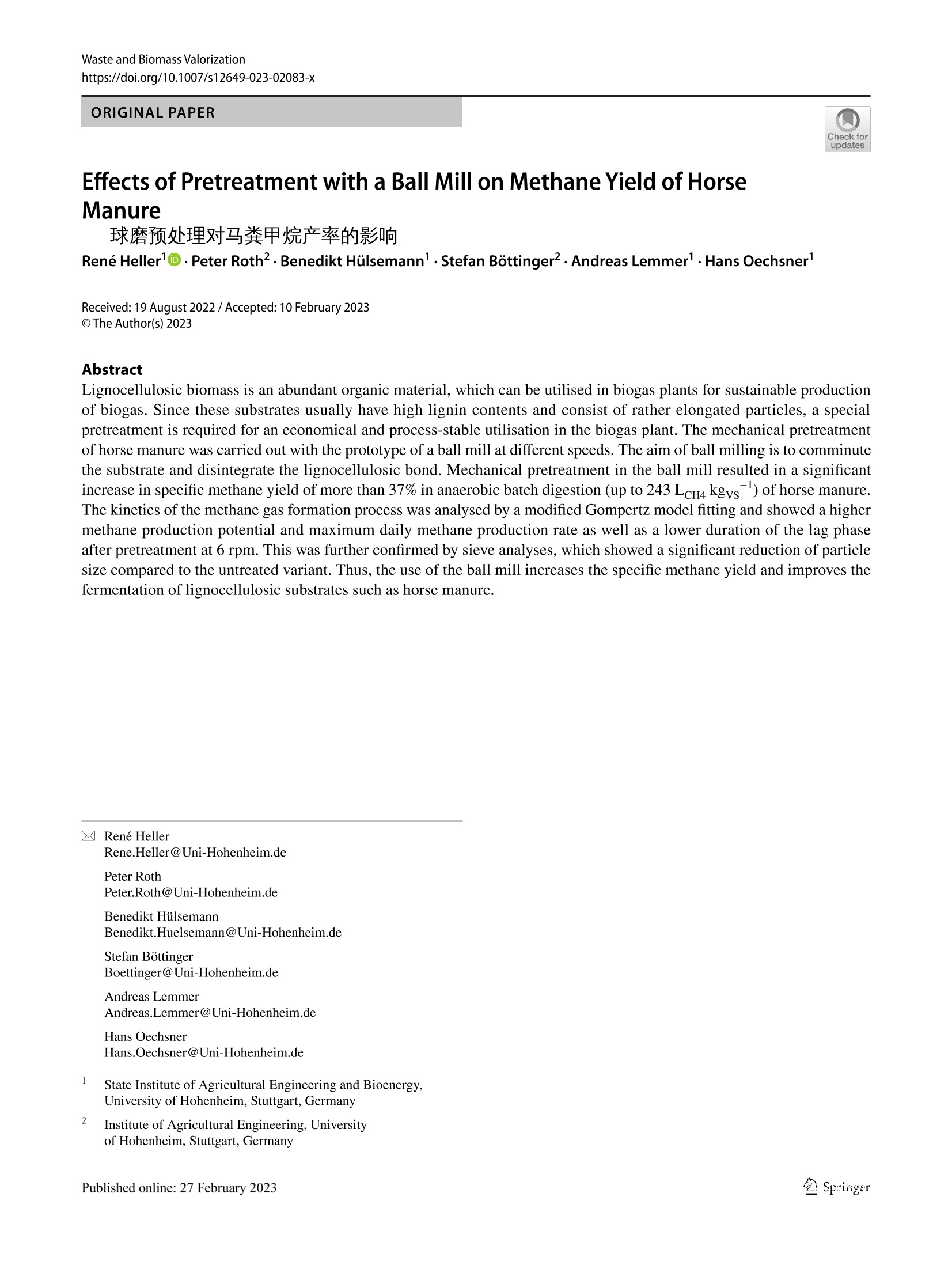
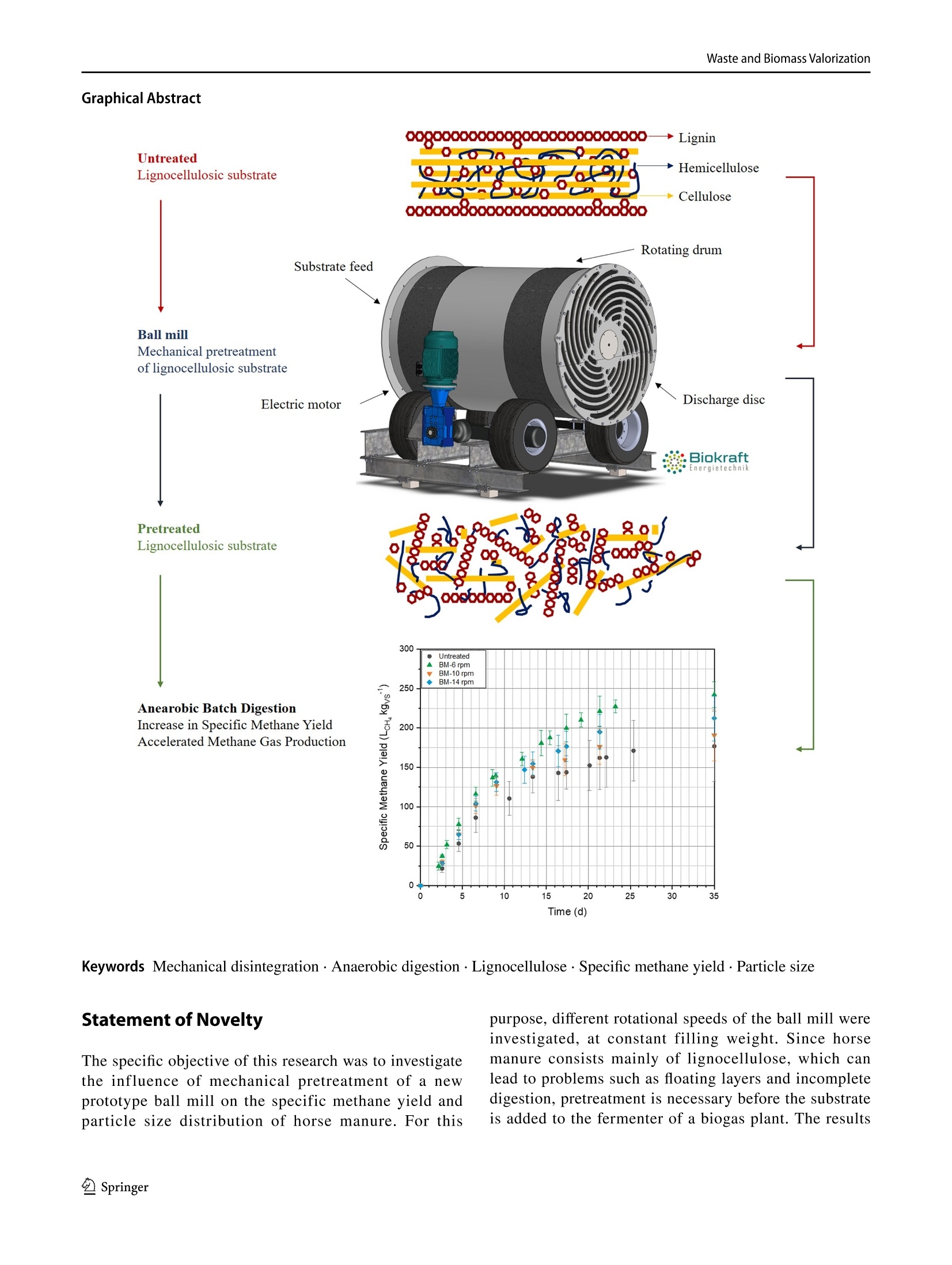

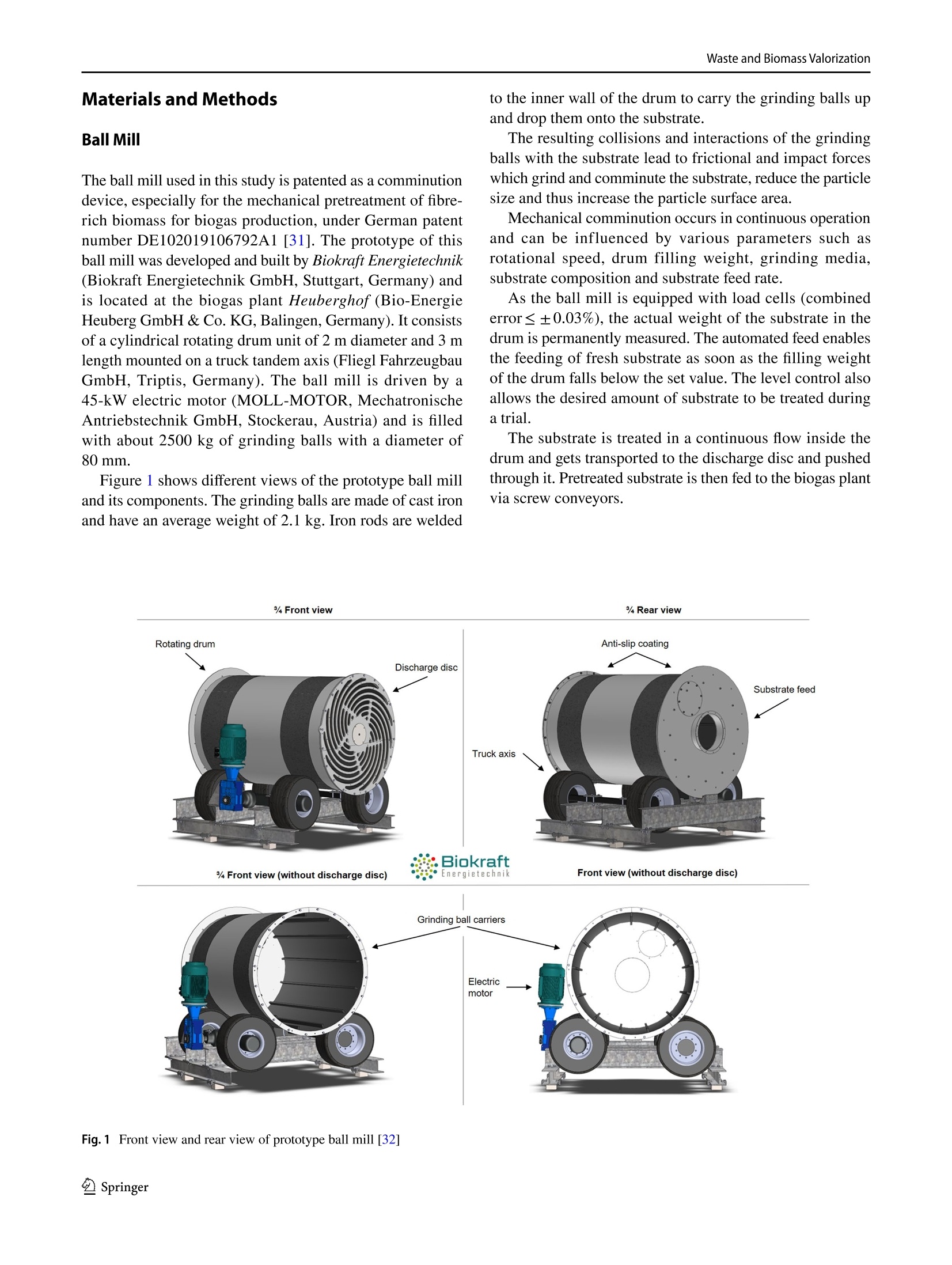
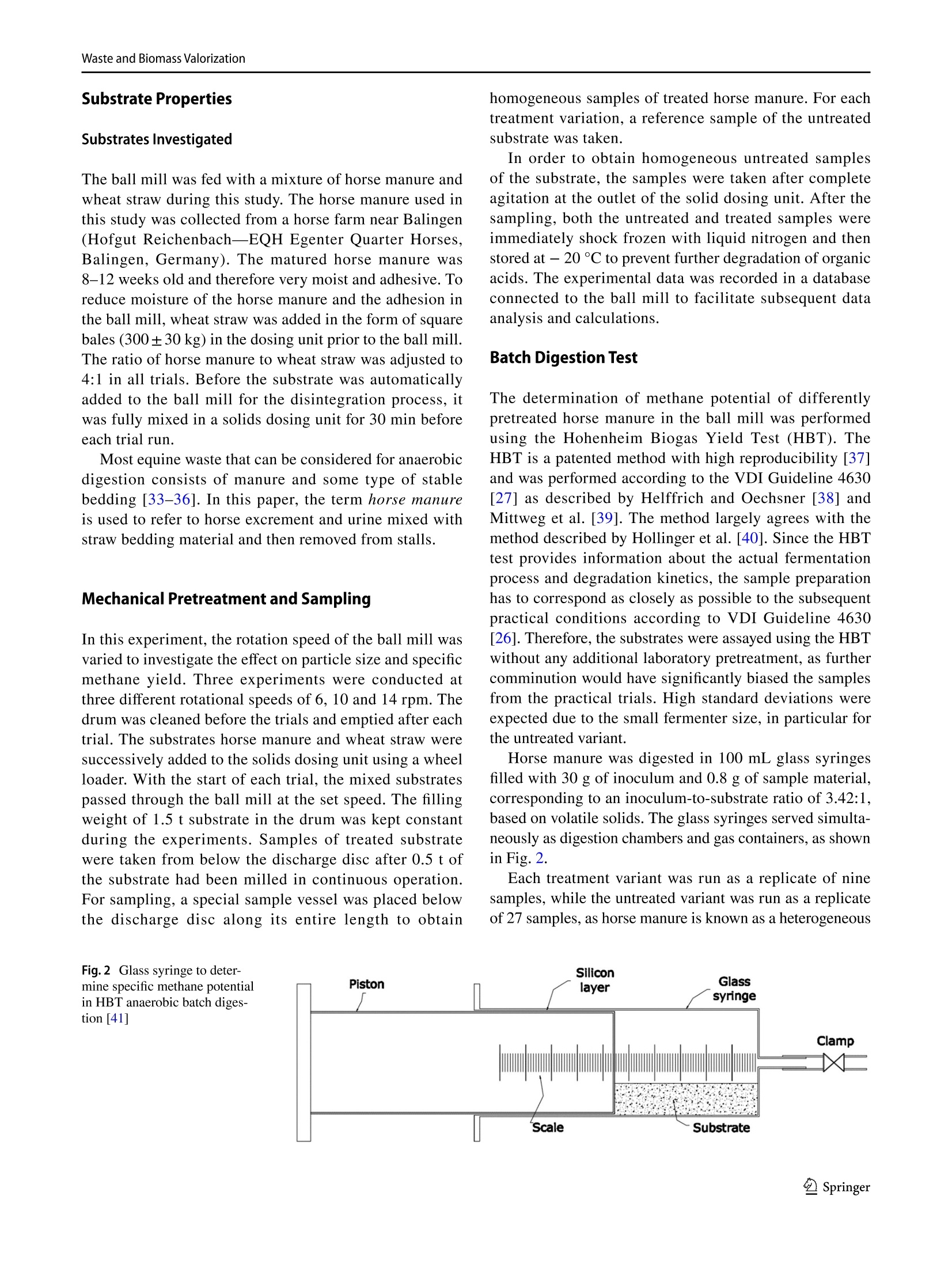

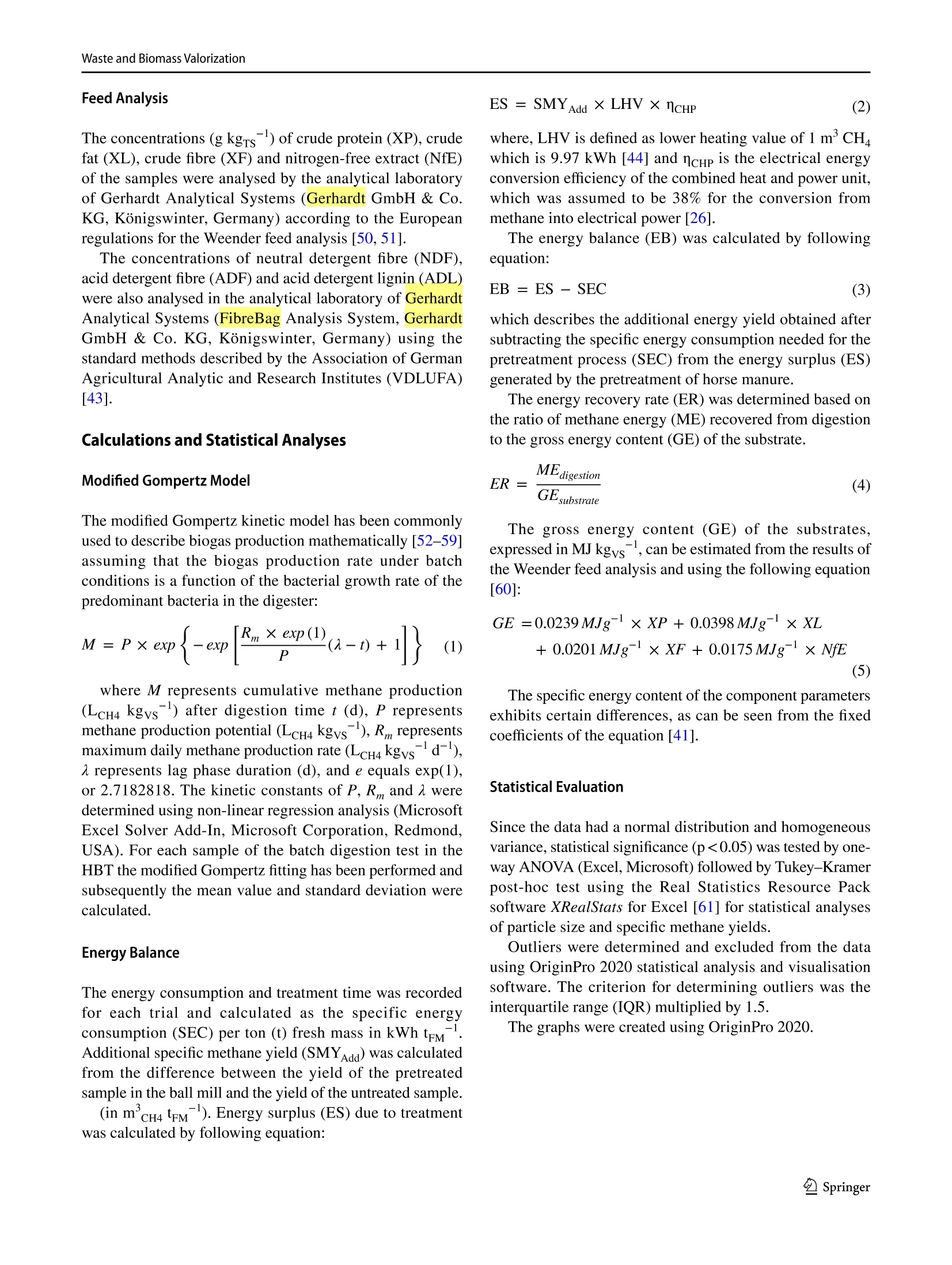

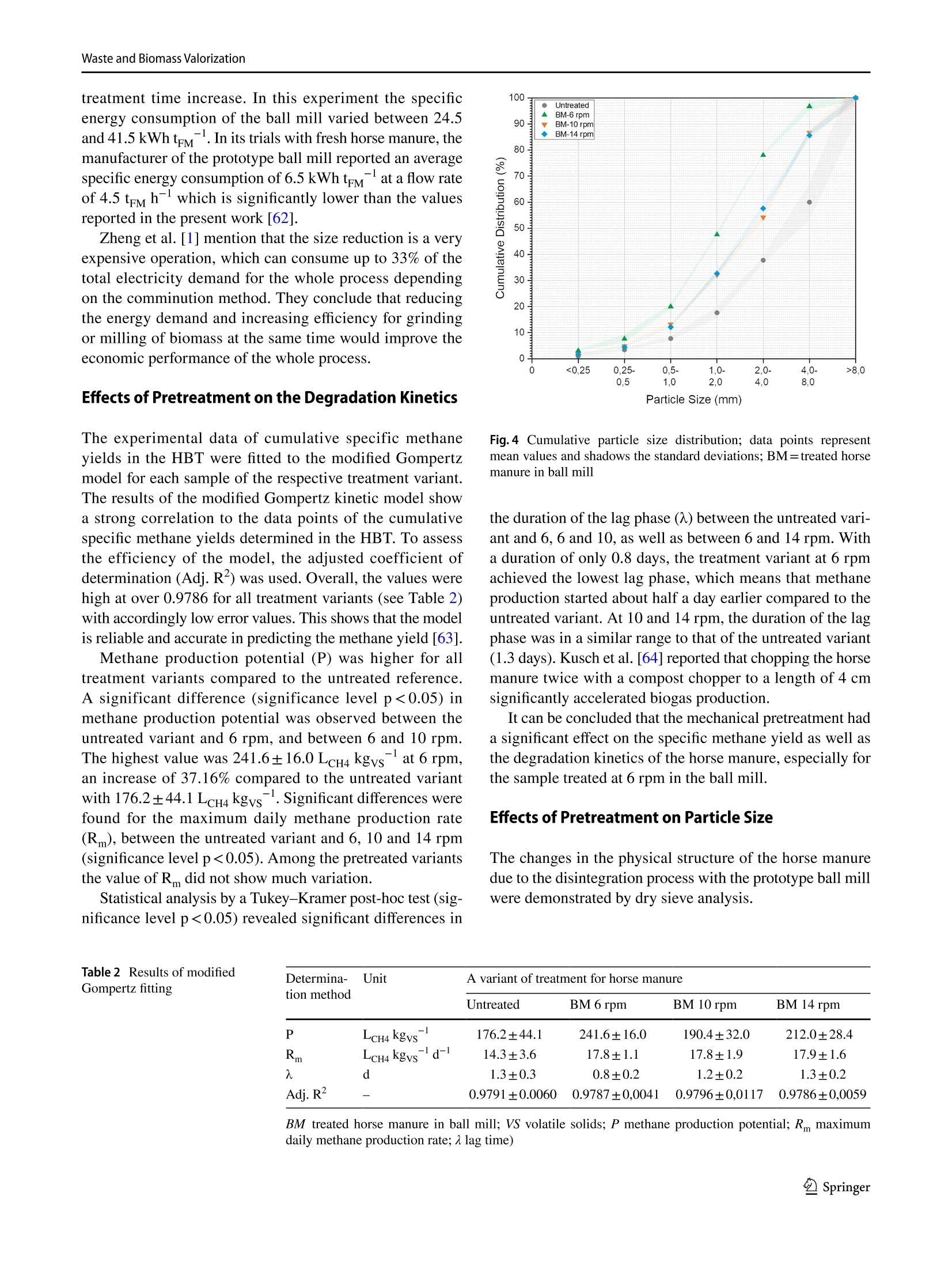
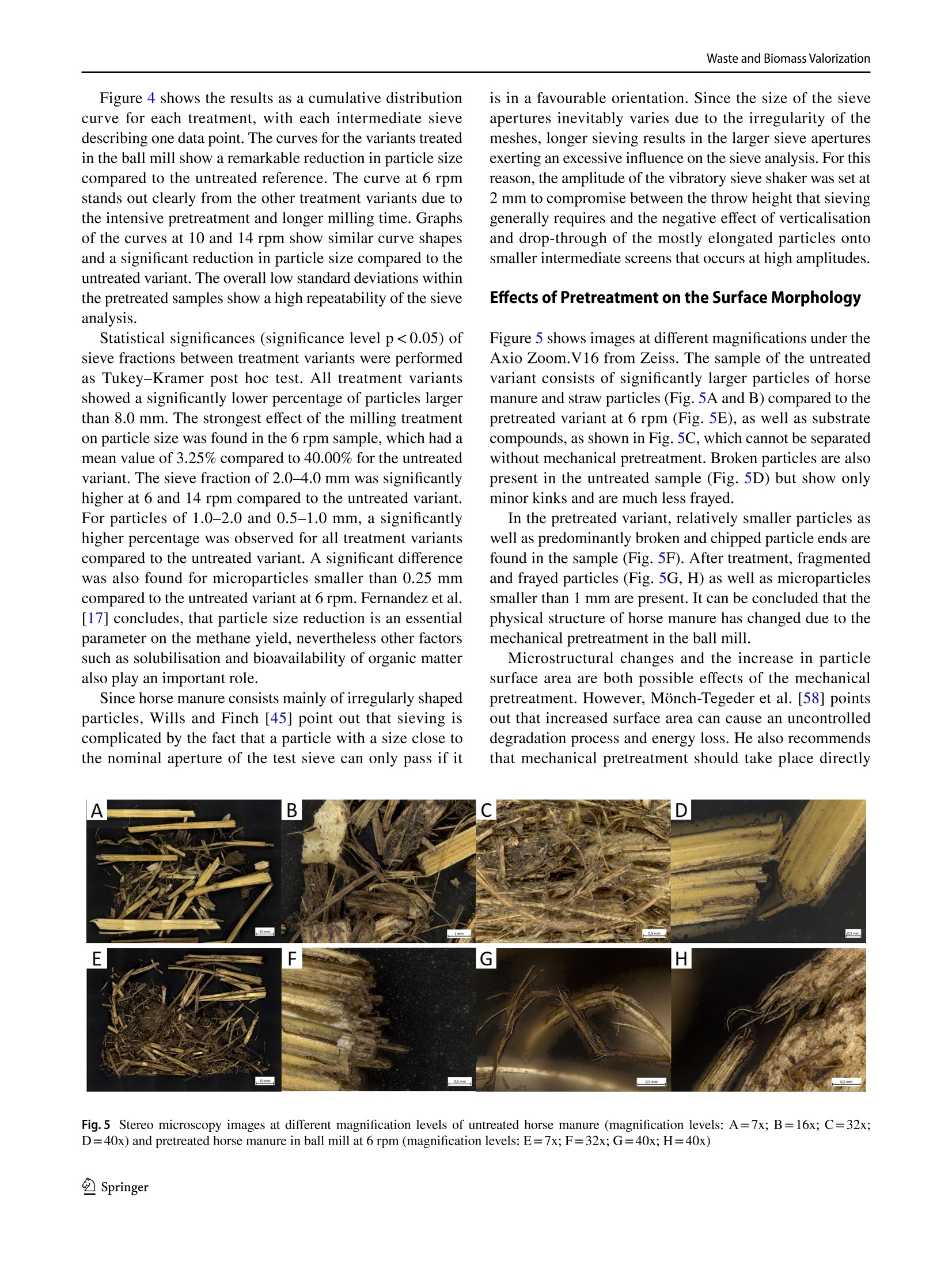
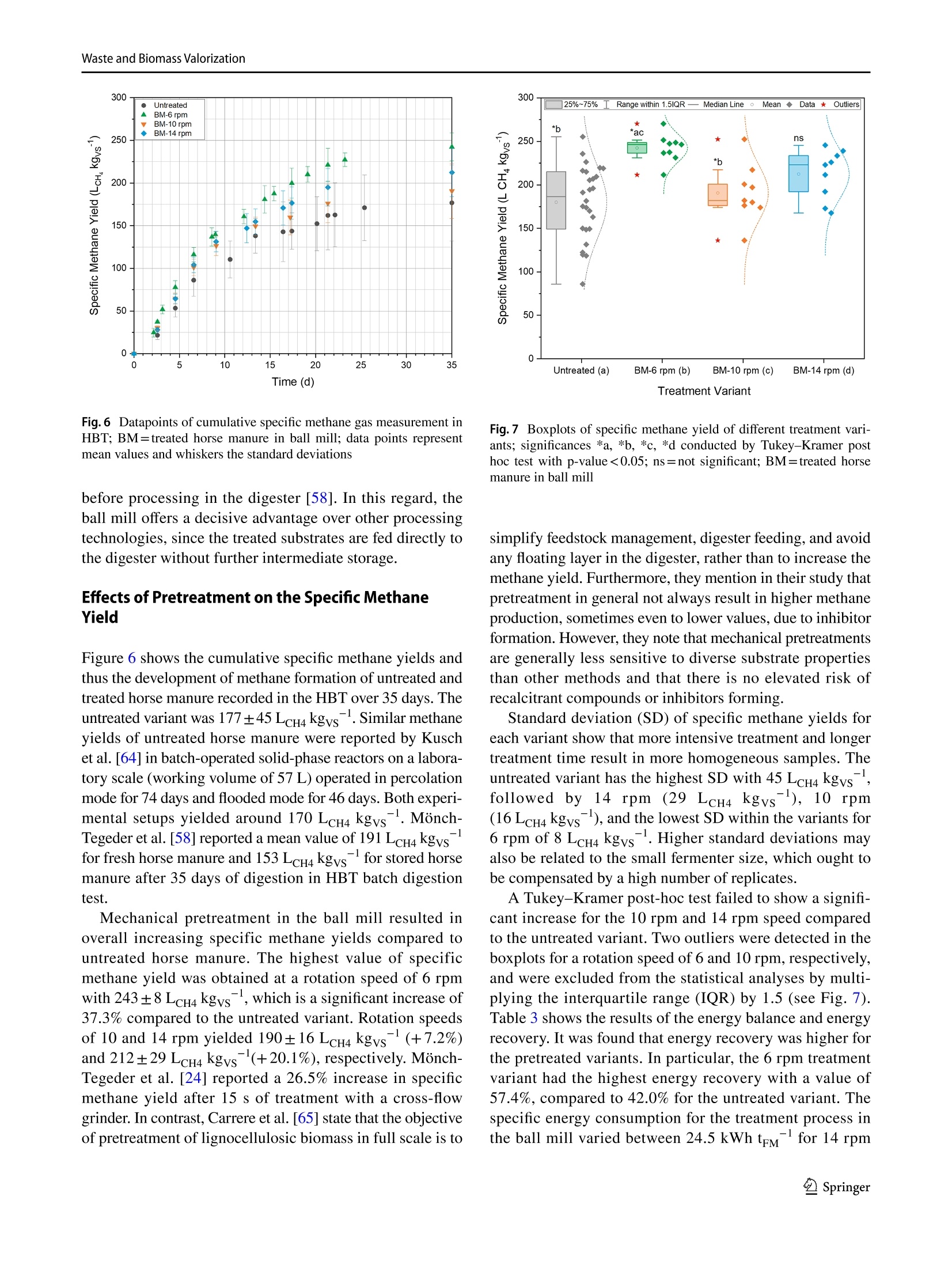

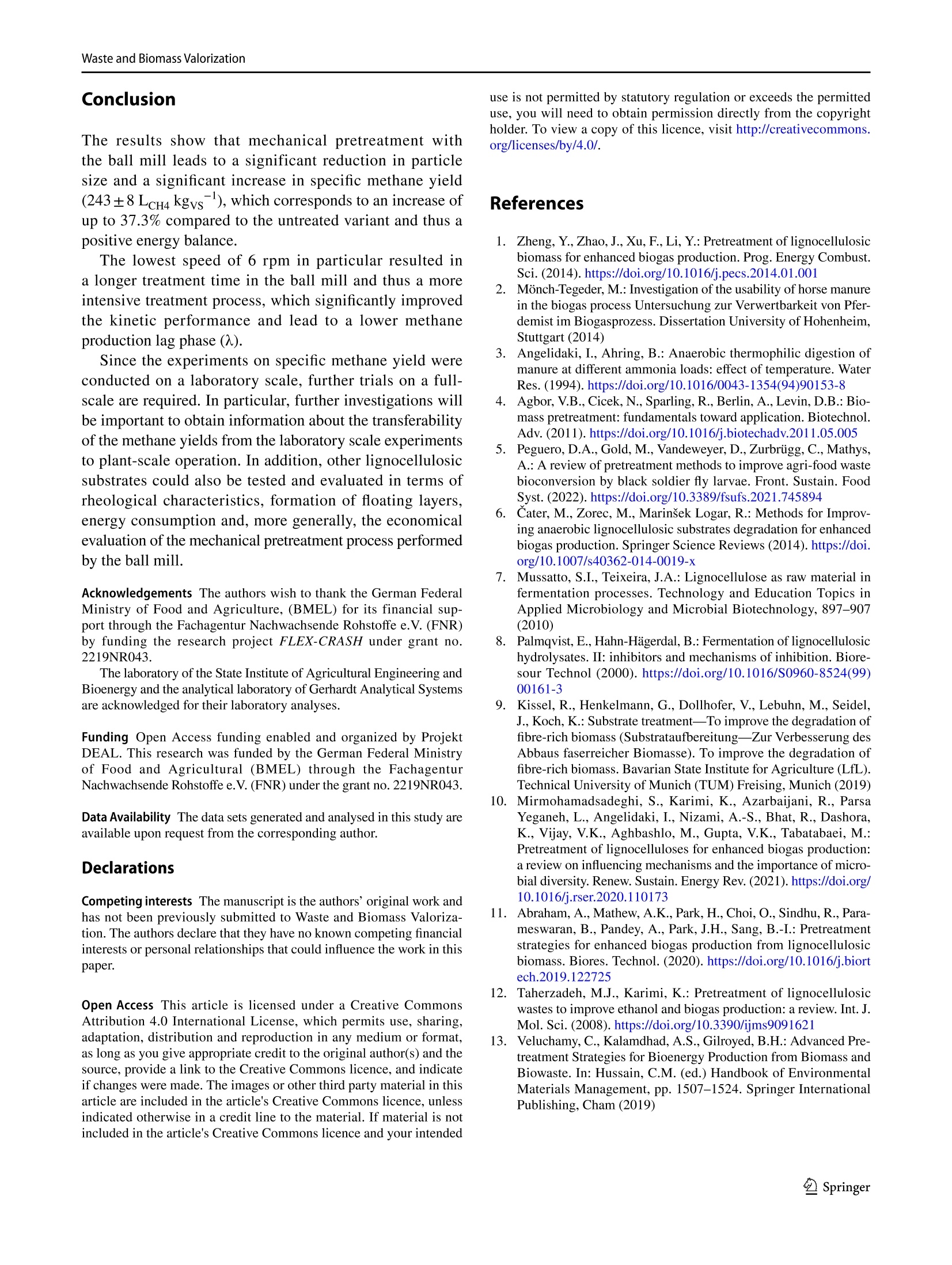
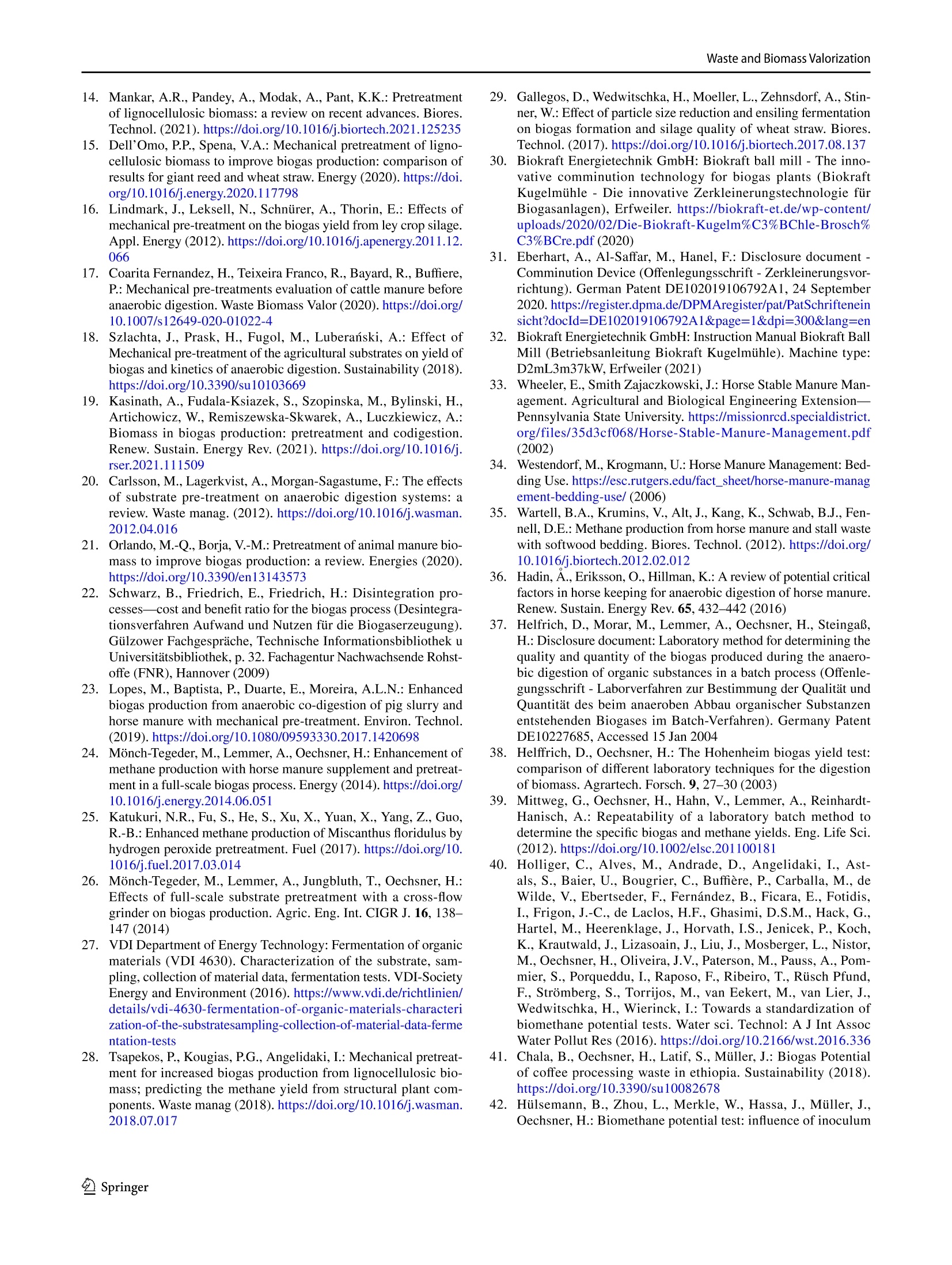
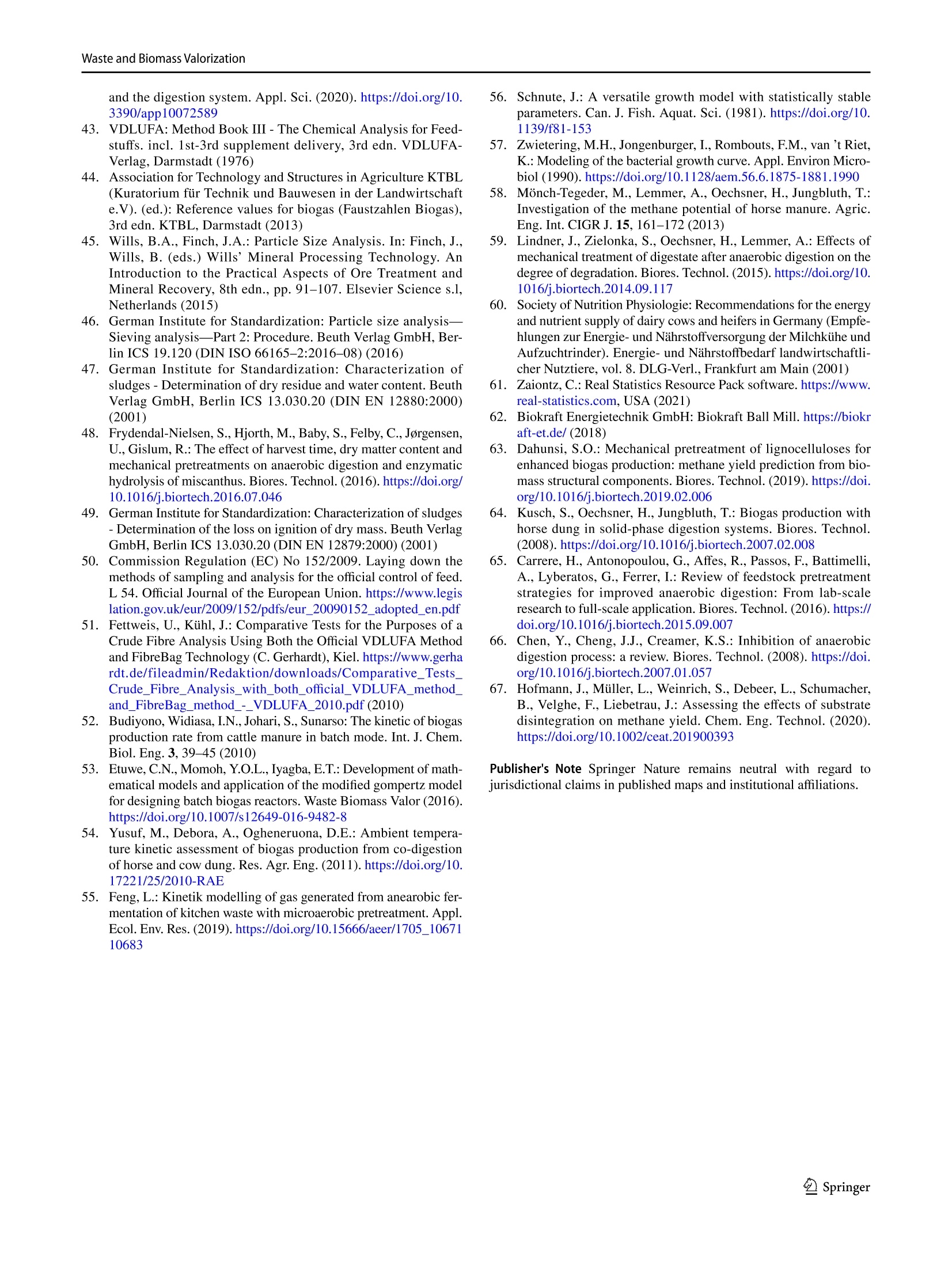
还剩13页未读,是否继续阅读?
中国格哈特为您提供《马粪粗纤维、粗蛋白、粗脂肪、中性洗涤纤维、酸性洗涤纤维、酸洗木质素含量检测》,该方案主要用于生物质能中粗纤维、粗蛋白、粗脂肪、中性洗涤纤维、酸性洗涤纤维、酸洗木质素检测,参考标准--,《马粪粗纤维、粗蛋白、粗脂肪、中性洗涤纤维、酸性洗涤纤维、酸洗木质素含量检测》用到的仪器有格哈特全自动型纤维分析仪FT12、格哈特全自动超级总脂肪测定系统HT6+SOX416、格哈特凯氏消化系统KT8S、格哈特维克松废气实验室废物处理系统涤气VS、格哈特带自动进样器凯氏定氮仪VAP500C、德国加液器MM
相关方案
更多










